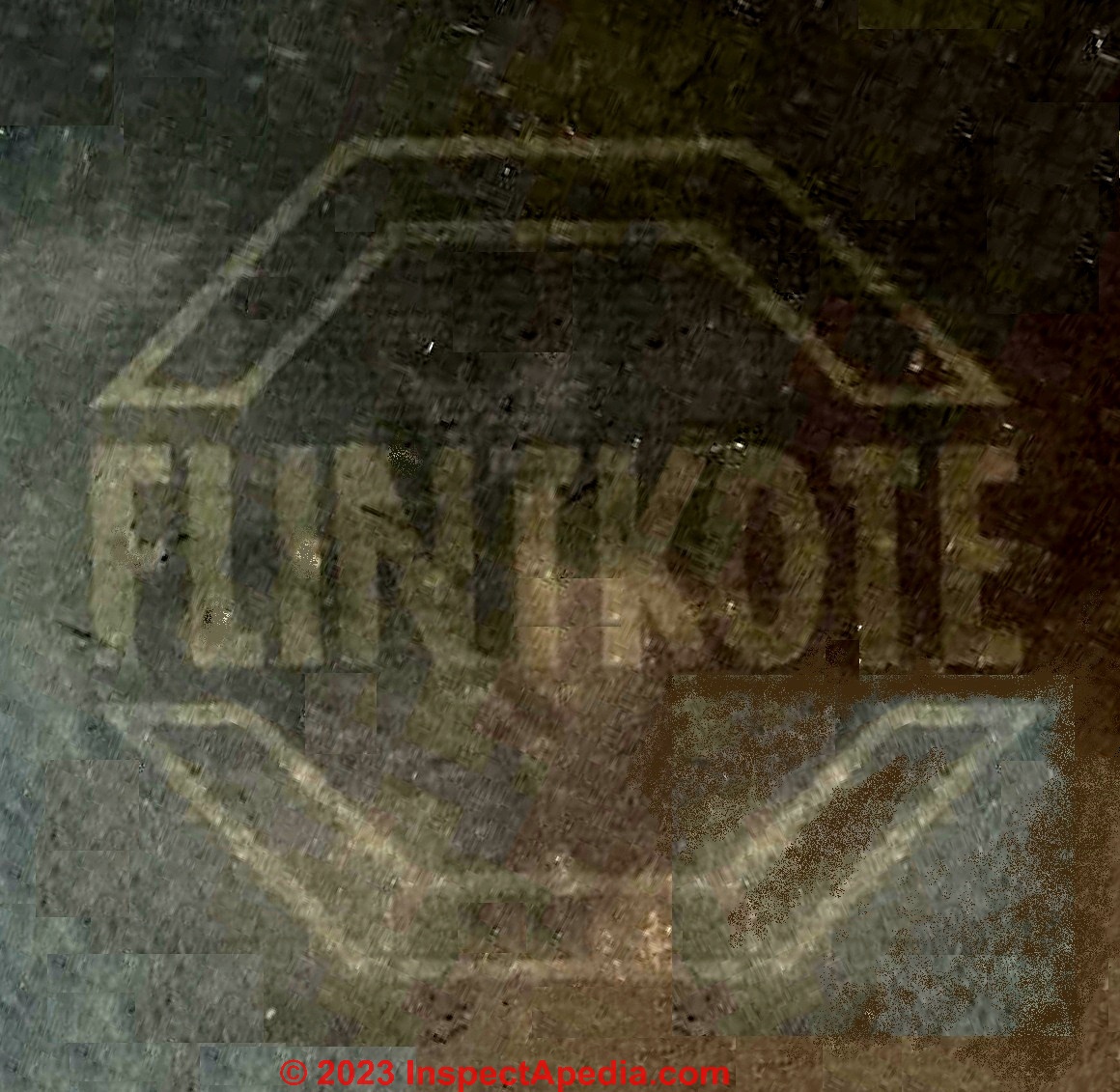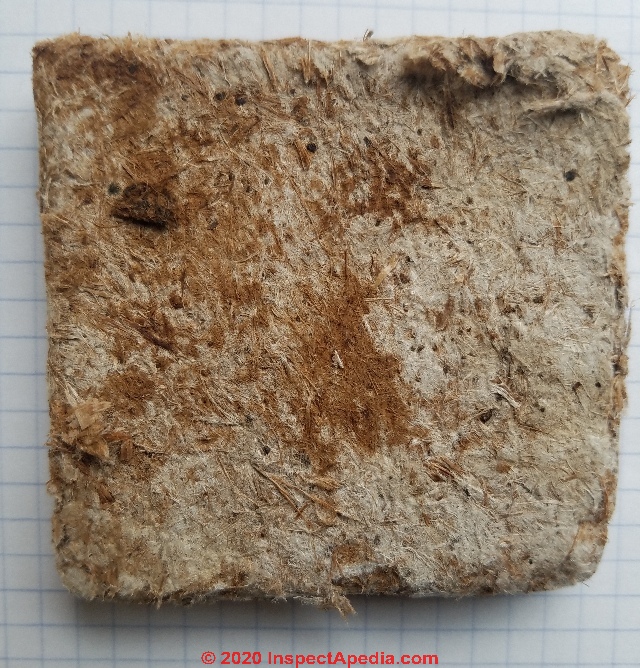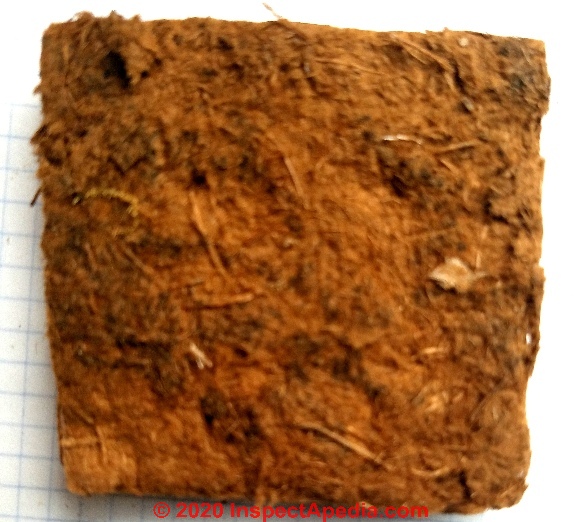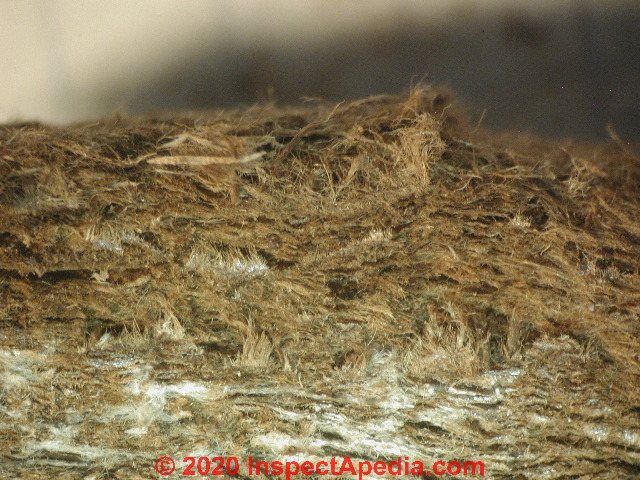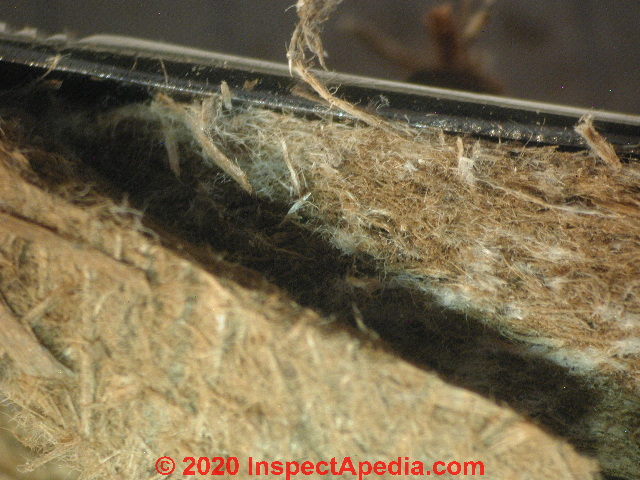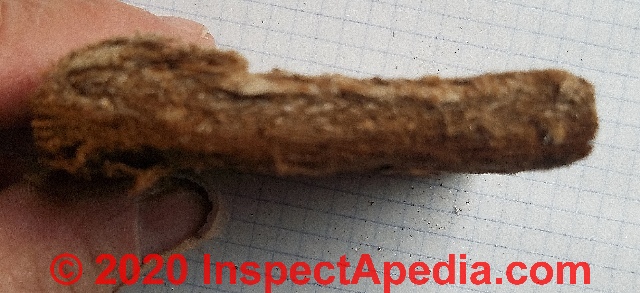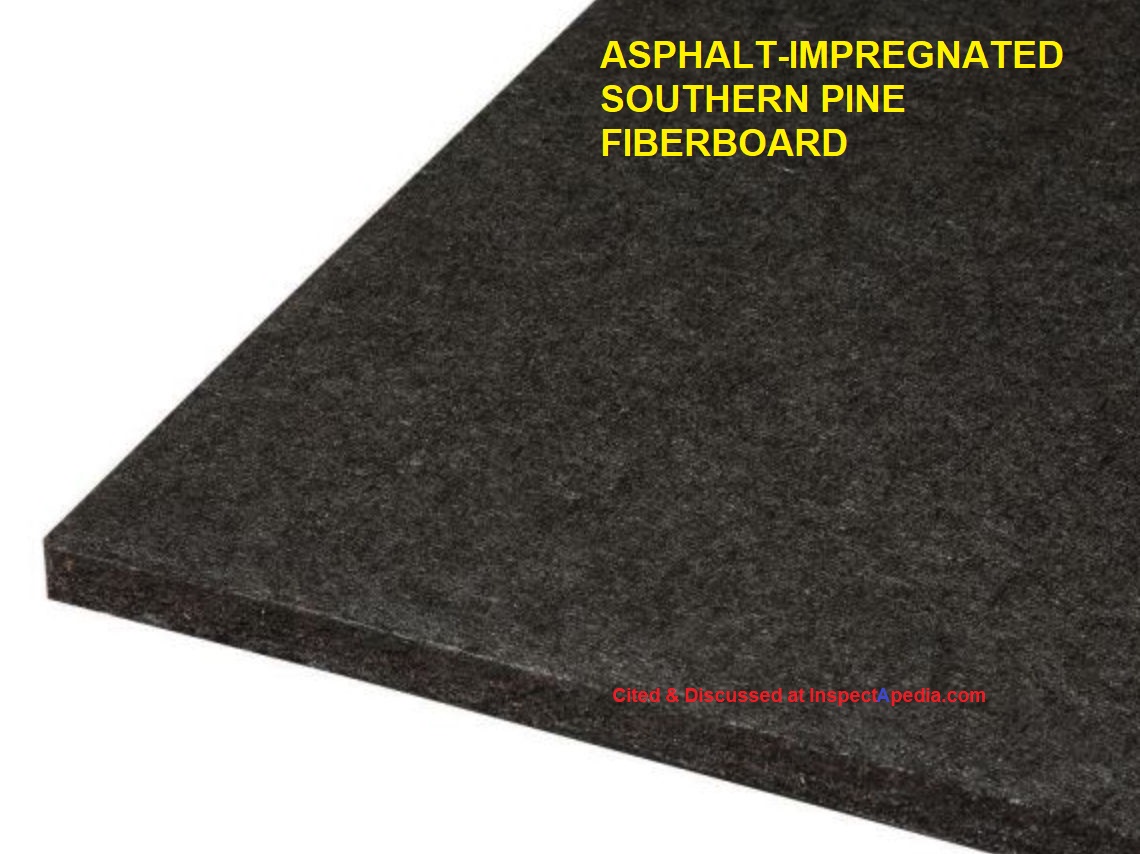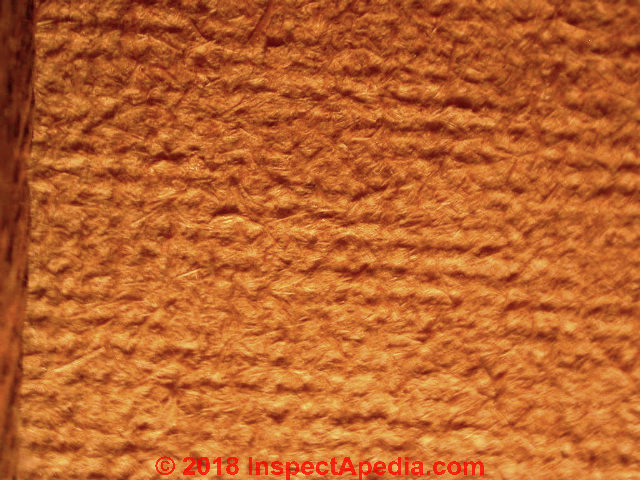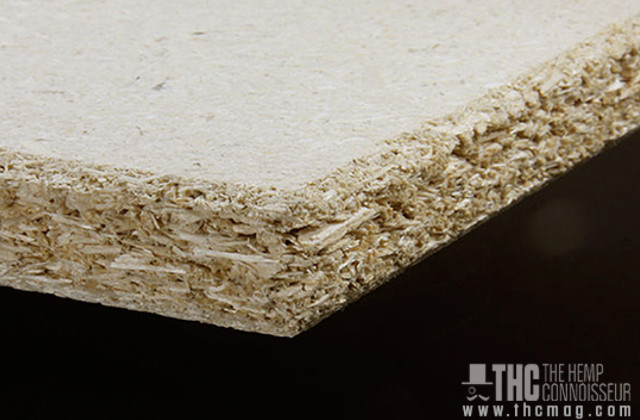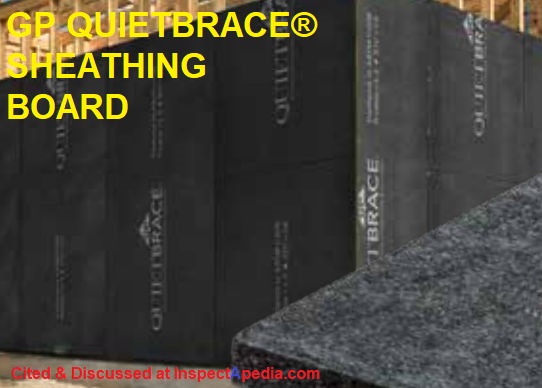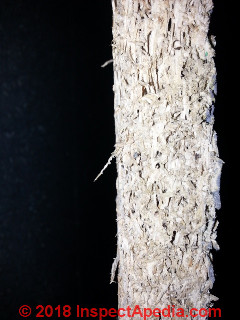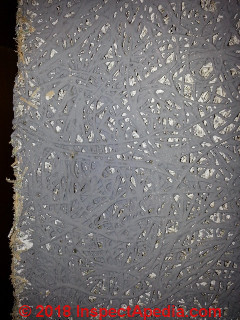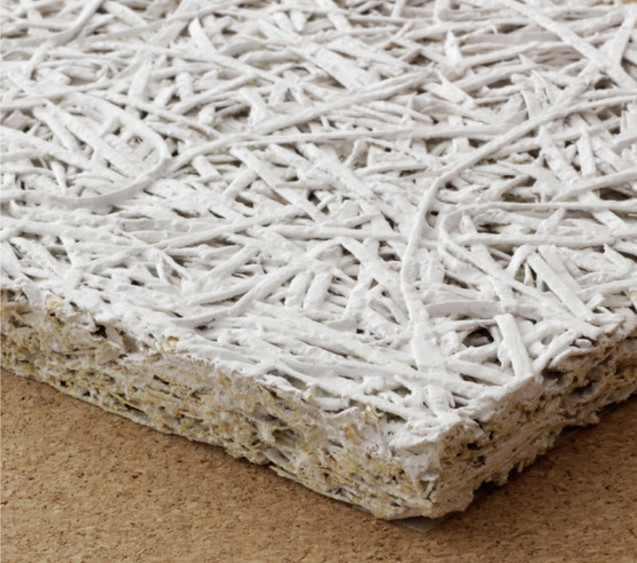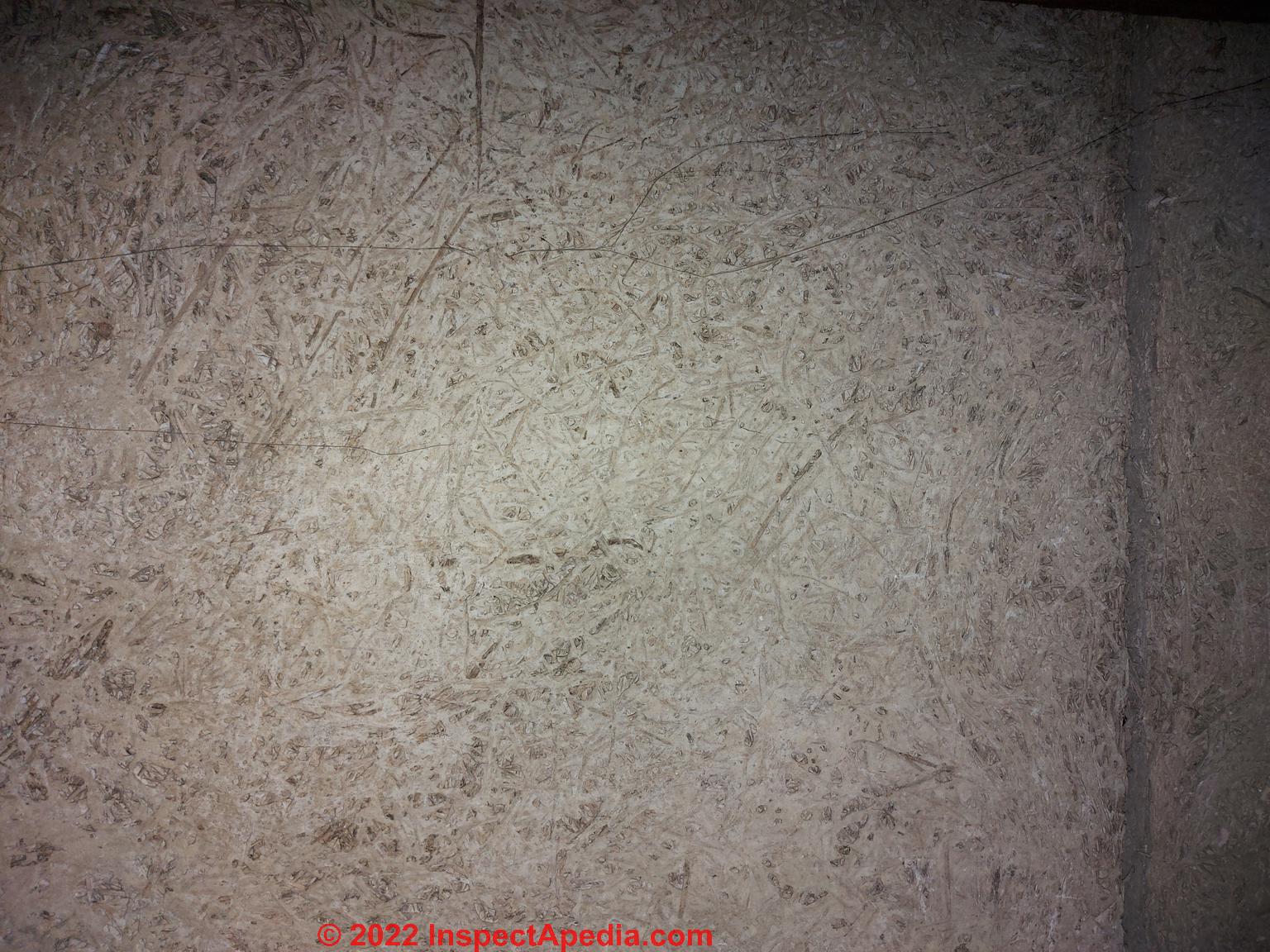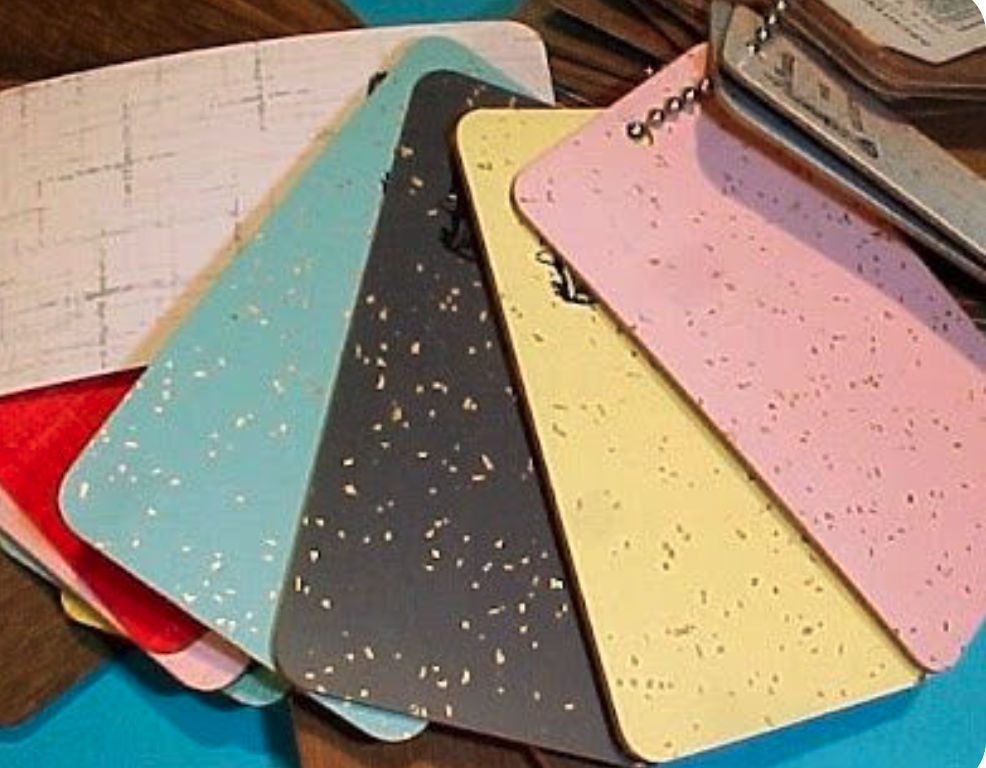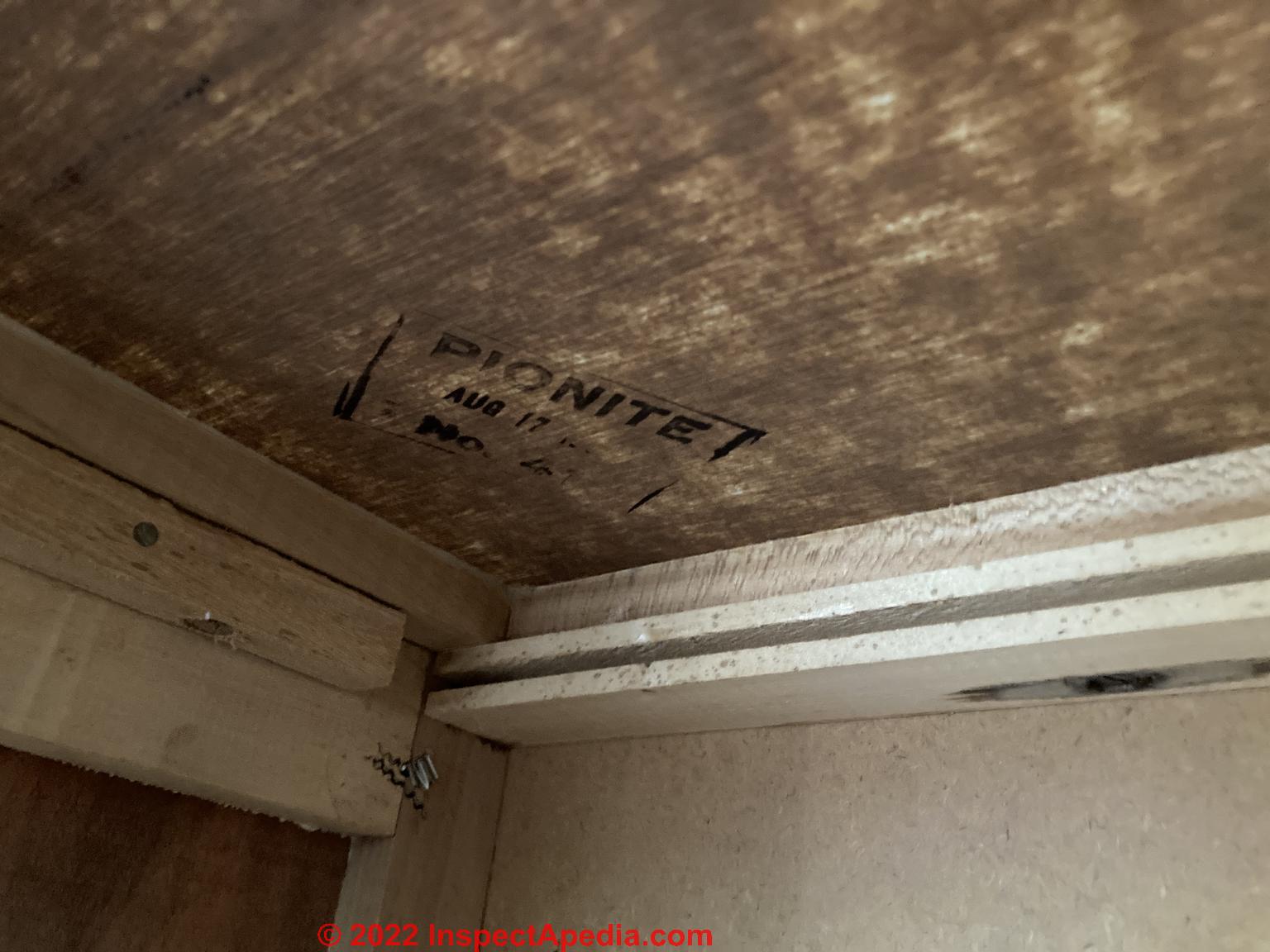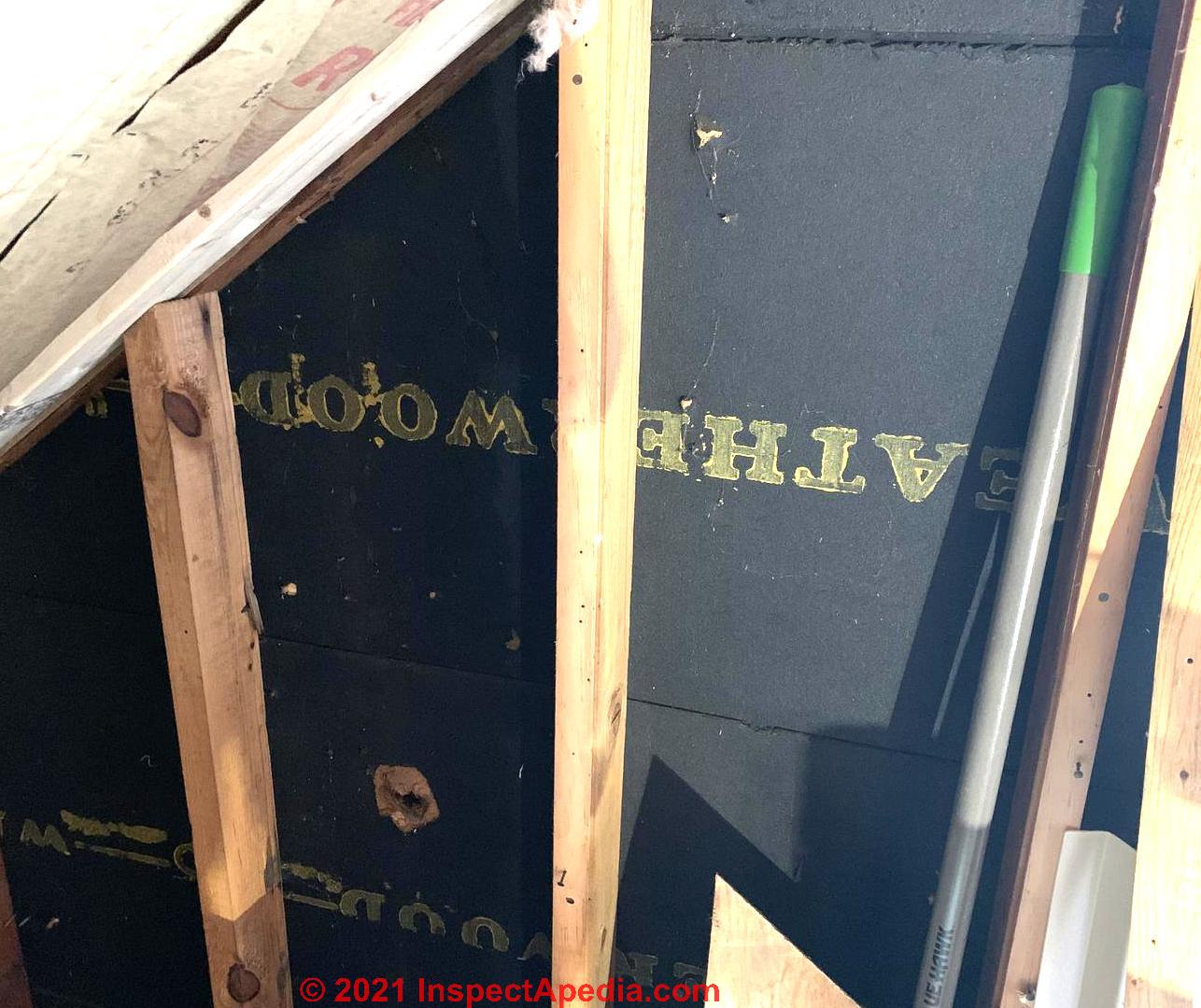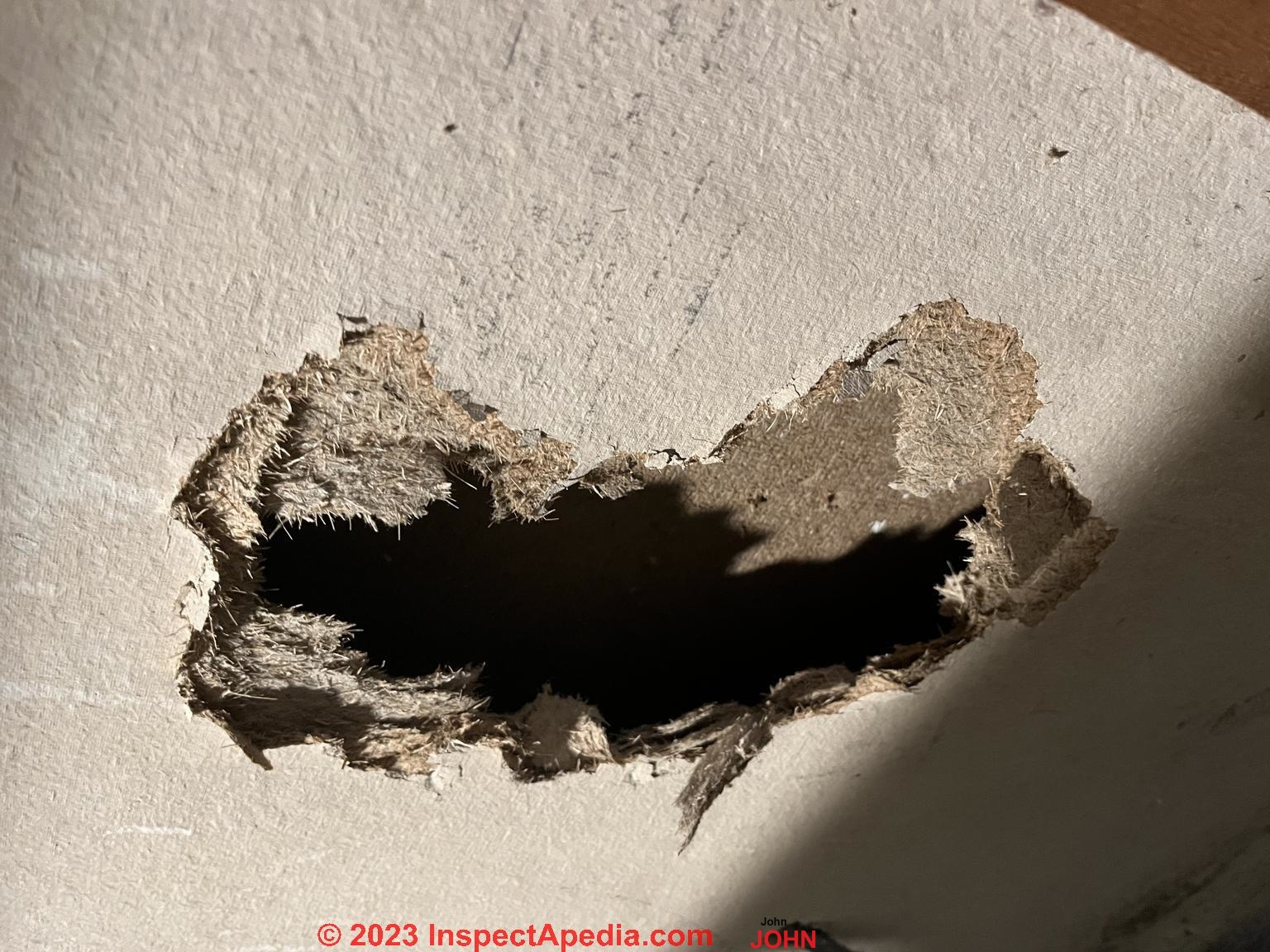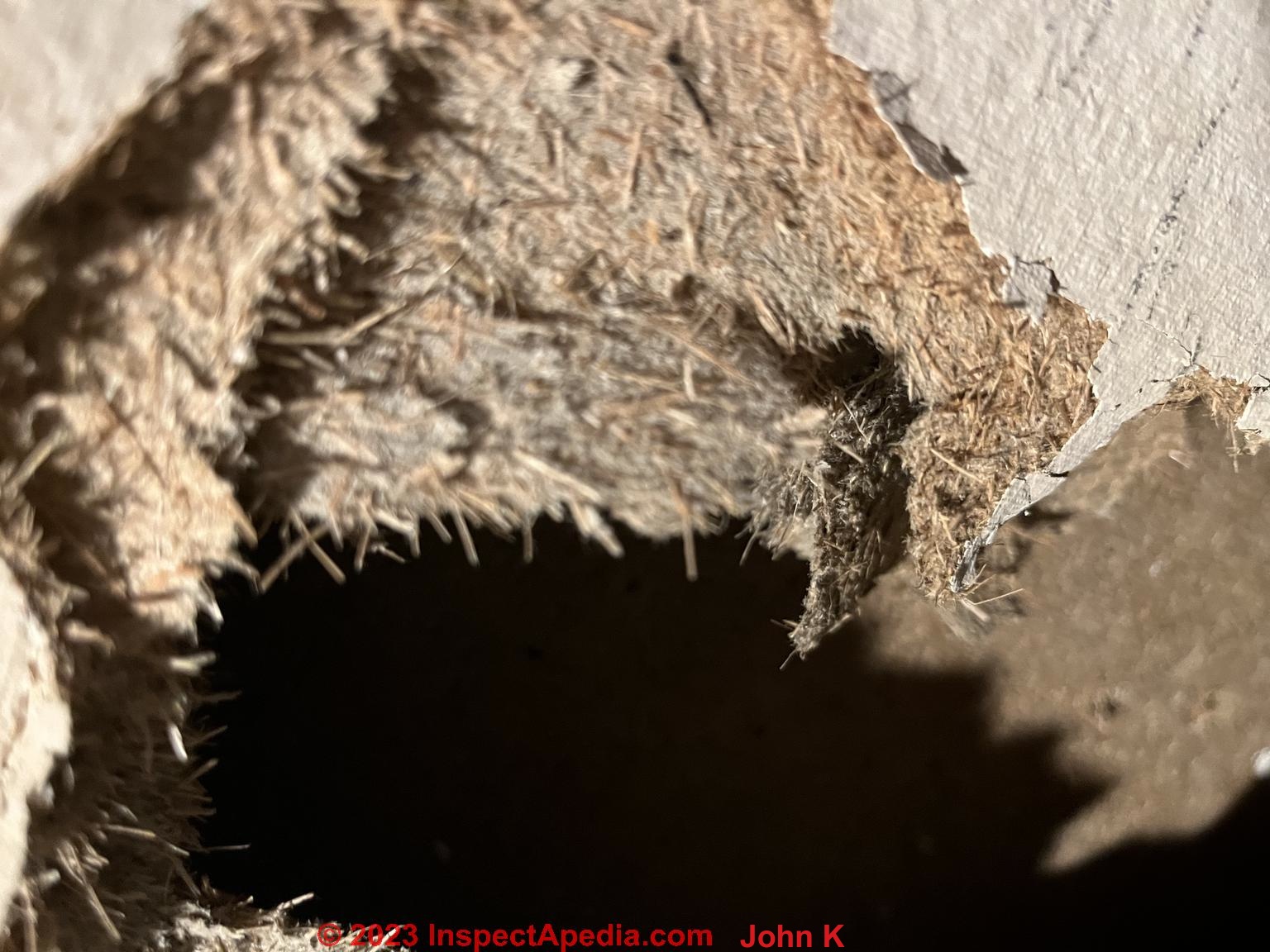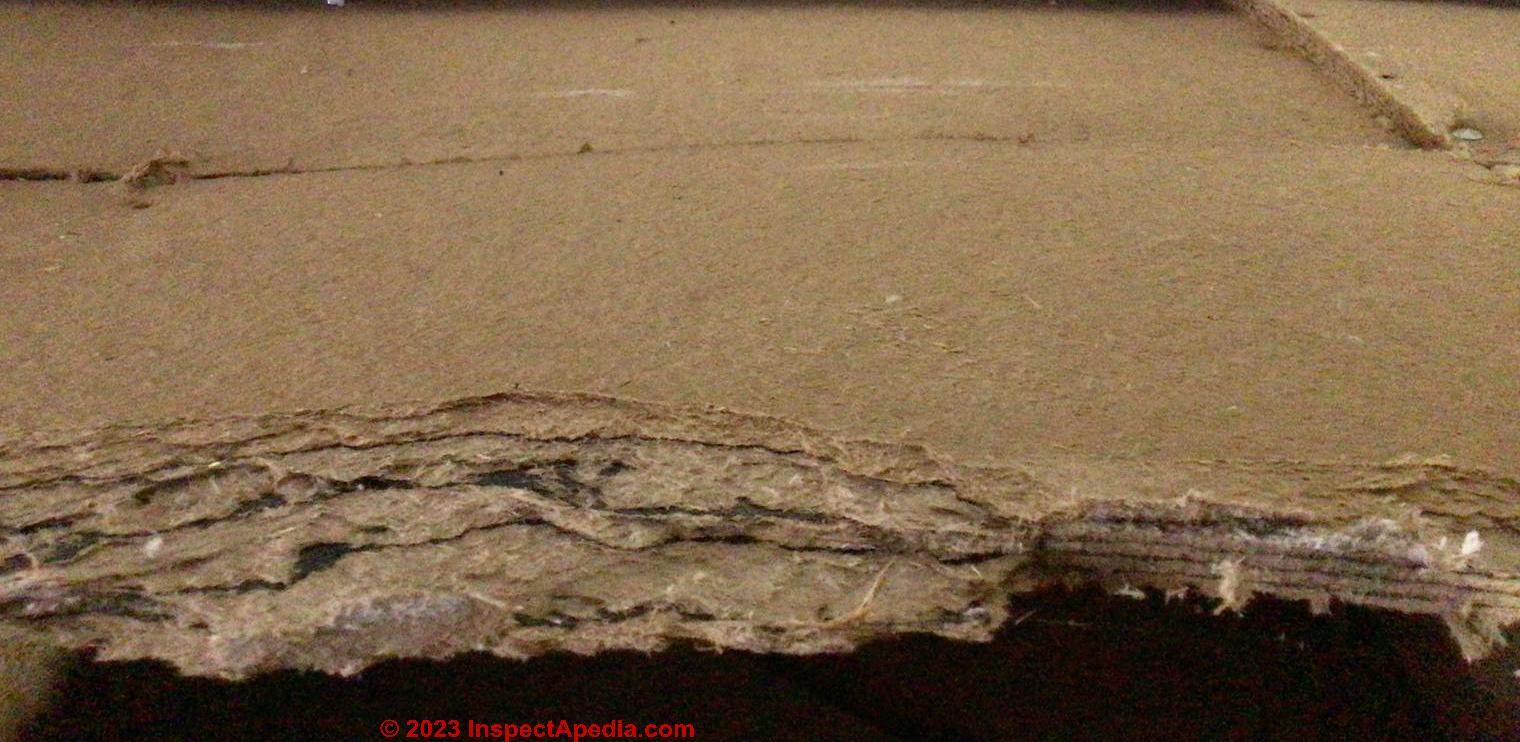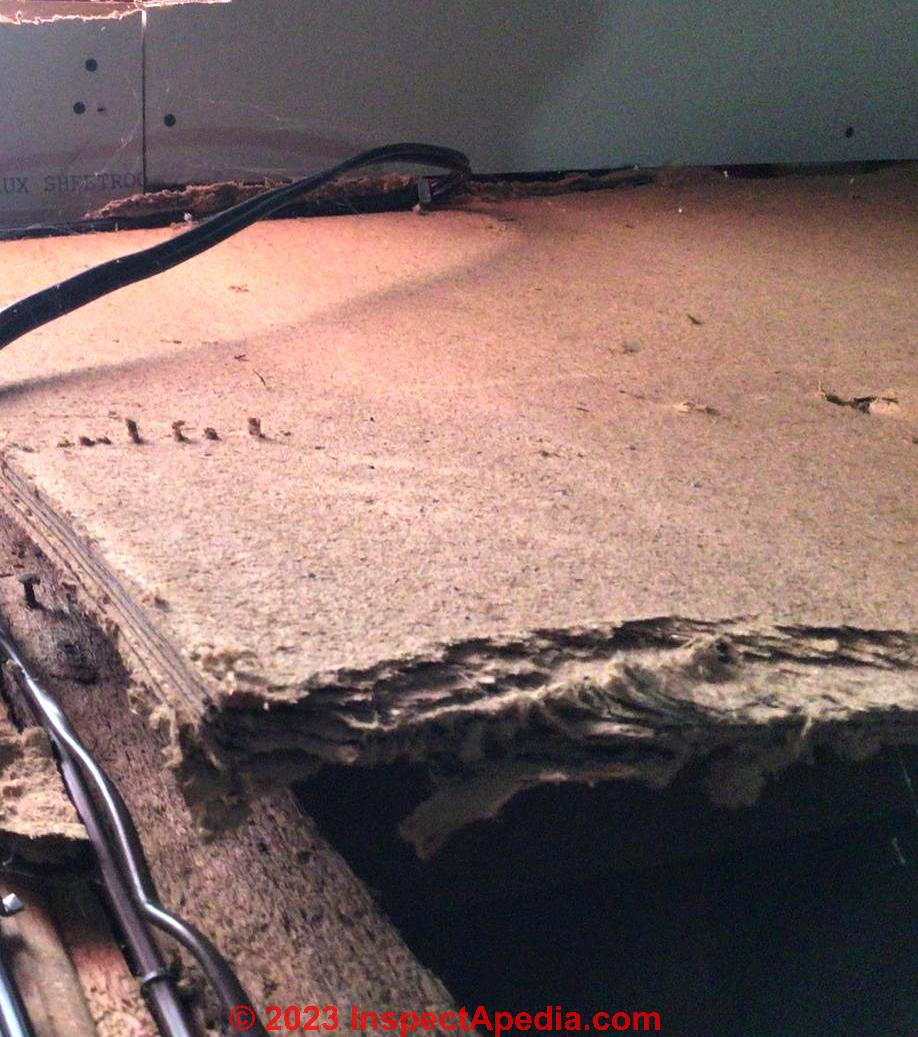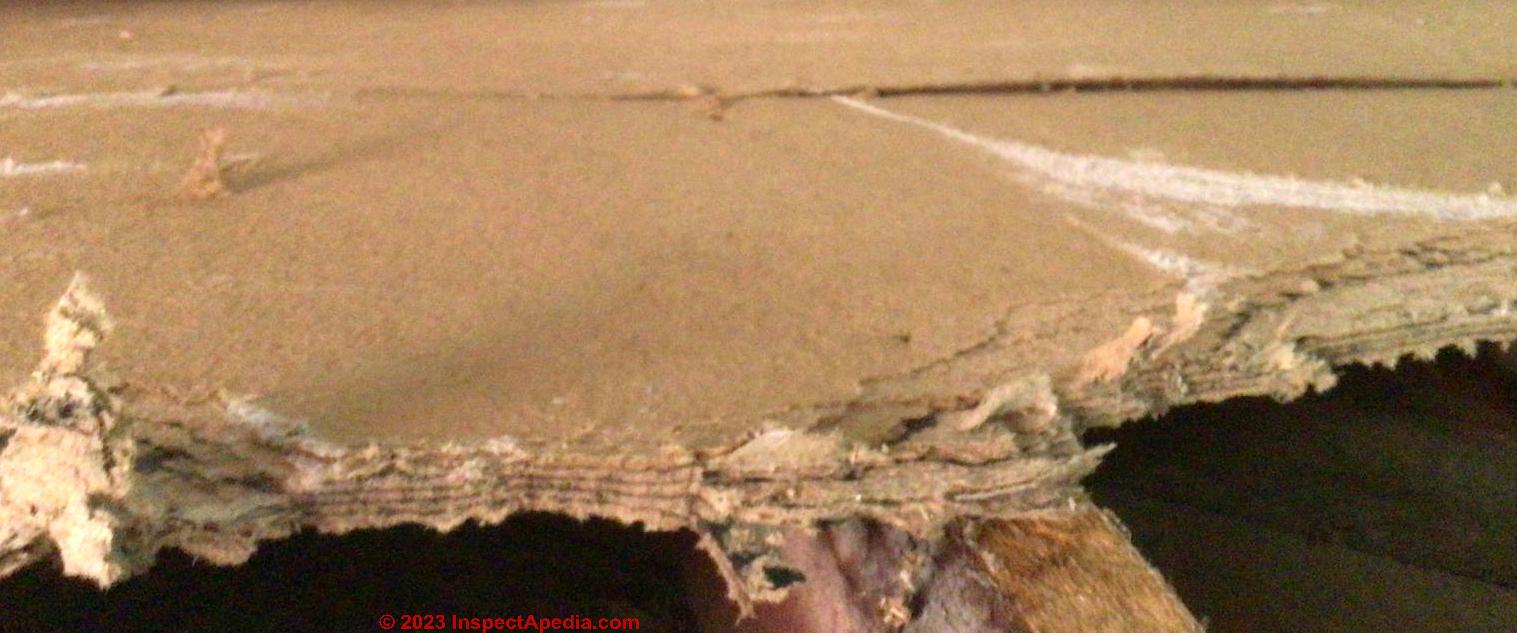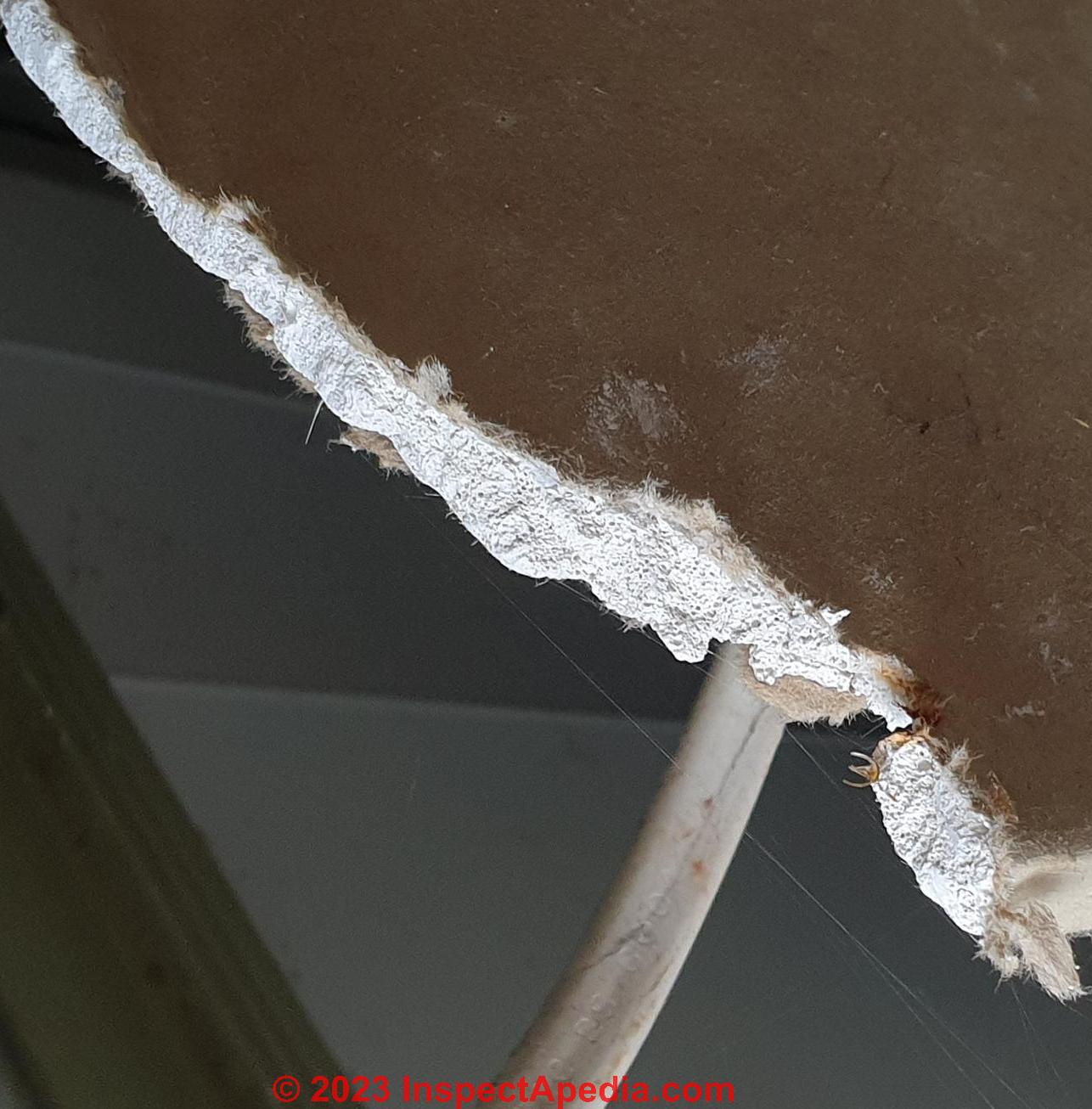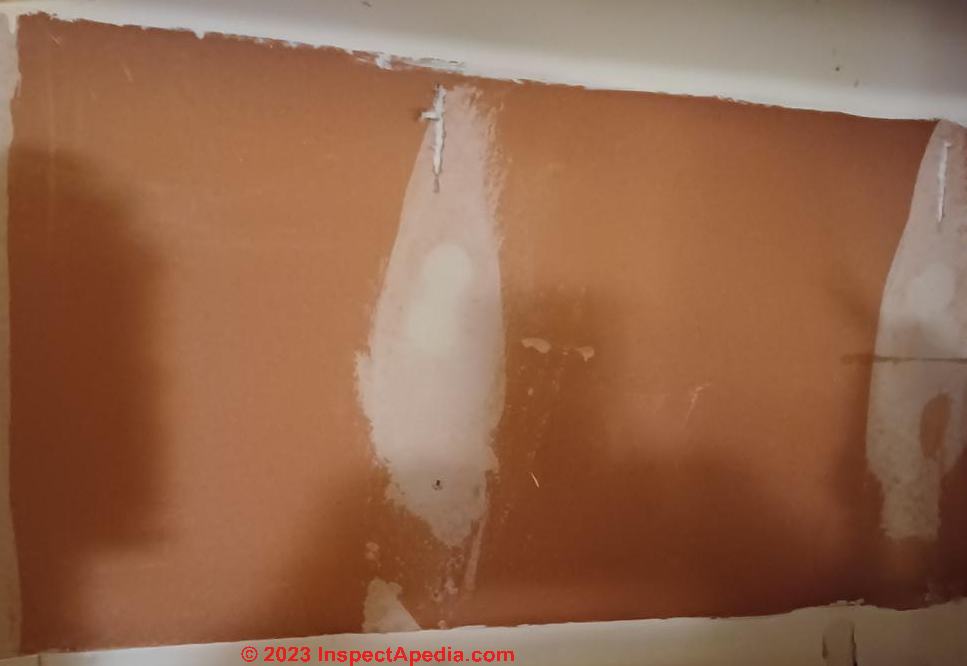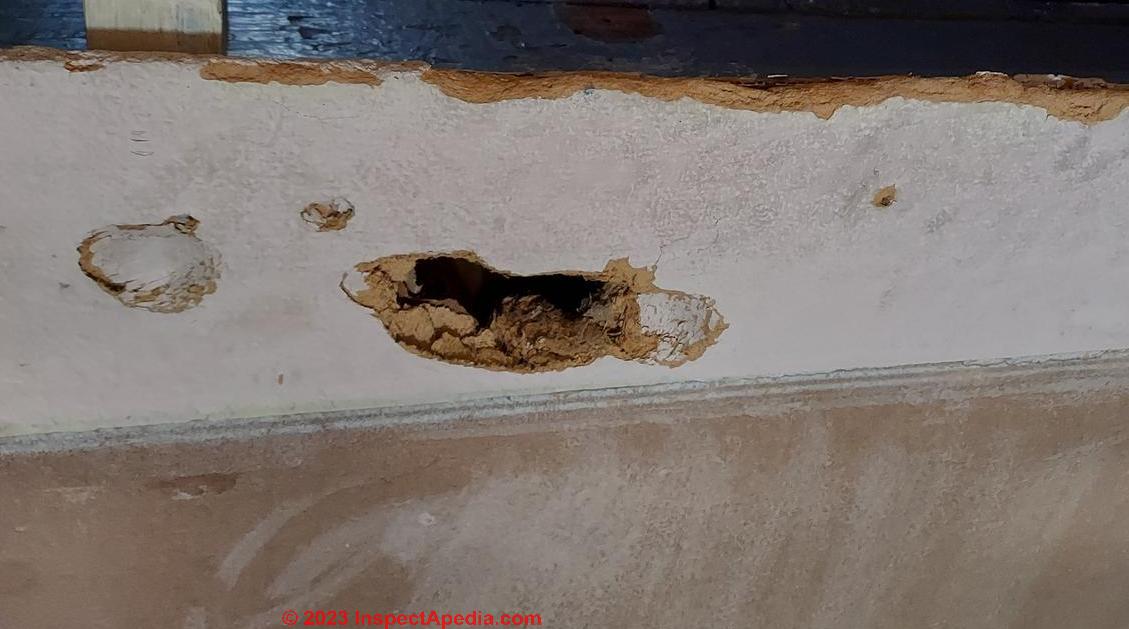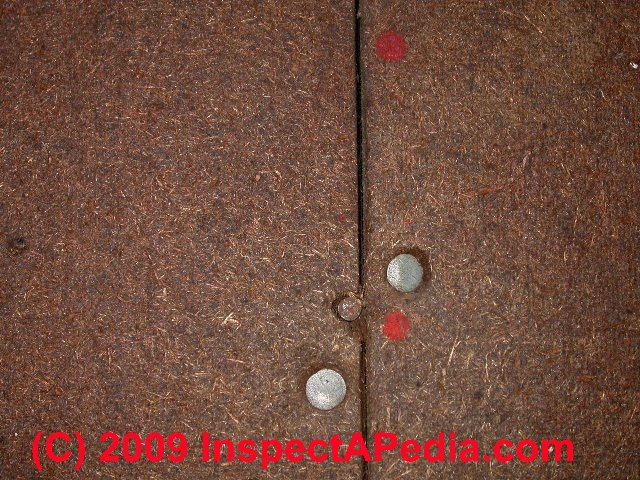 Asbestos in Fiberboard Building Sheathing & Insulating Board
Asbestos in Fiberboard Building Sheathing & Insulating Board
Fiberboard Asbestos Test Results
- POST a QUESTION or COMMENT about fiberboard building sheathing: how to identify fiberboard products, fiberboard uses, fiberboard, Celotex, Homasote, Insulite & other brands, fiberboard ingredients, does fiberboard contain asbestos?
Is there any asbestos found in fiberboard sheathing products?
Here we discuss asbestos hazards for fiberboard panels, sheathing, insulating board & ceiling coverings or tiles.
We answer the question: does or did Celotex® fiberboard or or Georgia Pacific® fiberboard or Homasote® or other fiberboard and insulating board products contain asbestos?
We include research citations and testing lab referrals for concerned readers.
Fiberboard sheathing and Insulating Board products that were cellulose-based and that are discussed here include these brands and names: Beaverboard, Blackboard, Brownboard, Celotex insulating lumber, Georgia Pacific insulating board, Gold Bond insulating board panels, Homasote, Insulite, Nu-Wood Sta-Rite, and others.
This article series describes and provides photographs that aid in identifying various insulating board & fiberboard sheathing materials used on building walls and roofs, such as Homasote, Celotex, Insulite, and Masonite insulating board sheathing products. Here we provide fiberboard product names and we describe the components, properties, and applications of various fiberboard, hardboard, and insulating board or sound deadening board products.
InspectAPedia tolerates no conflicts of interest. We have no relationship with advertisers, products, or services discussed at this website.
- Daniel Friedman, Publisher/Editor/Author - See WHO ARE WE?
Is there Asbestos Content in Insulating Board Products: Beaverboard, Celotex, Gold Bond, Homasote, Insulite, Nu_Wood?
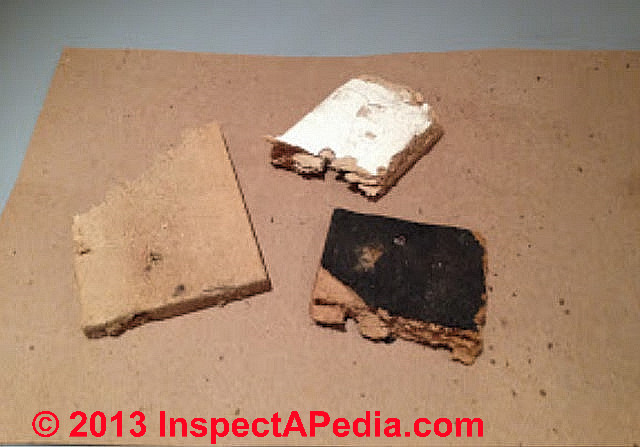 Bottom line: In most case, no. Most fiberboard products are plant-based. There are, however a few exceptions that we detail in this article.
Bottom line: In most case, no. Most fiberboard products are plant-based. There are, however a few exceptions that we detail in this article.
Worries about asbestos in fiberboard insulating sheathing and in some ceiling tile products form a question that comes up during building demolition and renovation.
The short answer is usually "no" for wood-based or plant-based fiberboard products and "yes" for certain other (not plant-based) LDB or LDF products specifically described as asbestos board; the history is interesting.
And the short answer is "maybe" for some ceiling board or ceiling tile products either deliberately mixing in asbestos or by possible cross contamination at very low levels.
Article Index - Insulating Board & Sheathing Board Products Asbestos Content
- ASPHALIC INSULATING SHEATHING BOARD
- ATLANTA GA FIBERBOARD ASBESTOS TEST RESULT
- ALLIED CHEMICAL / BARRETT SHEATHING ASBESTOS?
- ARCHITONIC FIBROUS INSULATION BOARD - Coarse wood fiber board products
- BEAVERBOARD ASBESTOS CONTENT?
- BLACKBOARD ASBESTOS CONTENT
- BROWNBOARD ASBESTOS CONTENT
- CELOTEX BLUE RIDGE FIBERBOARD PRODUCTS - separate article
- CELOTEX INSULATING BOARD ASBESTOS CONTENT - separate article
- DONNACONA BOARD ASBESTOS CONTENT? - No. See this separate article
- ESCLAD FIBERBOARD & FOAM SHEATHING - separate article
- Fir-Tex or FIRE-TEX ASBESTOS?
- FLINTKOTE Stalwart™ SHEATHING ASBESTOS - separate article
- FLINTKOTE ASBESTOS PRODUCTS GUIDE - separate article
- GEORGIA PACIFIC IB INSULATING BOARD ASBESTOS?
- GP QUIETBRACE STRUCTURAL SHEATHING
- GOLD BOND IB ASBESTOS?
- GRAYLITE BOARD ASBESTOS?
- GYPSUM BOARD is not FIBERBOARD - separate article
- HARDBOARD Masonite™-like INGREDIENTS
- HOMASOTE ASBESTOS?
- HOMASOTE GYPSUM CORE SHEATHING ASBESTOS? - separate article
- INSULITE BOARD ASBESETOS?
- LOW DENSITY FIBERBOARD ASBESTOS PRODUCTS - Watch out: some LDF contains high levels of asbestos
- NUWOOD ASBESTOS CONTENT - board products & ceiling tiles
- PIONITE & FURNITURE ASBESTOS? - plastic laminate topped furniture or counters
- SIMPSON FIBERBOARD ASBESTOS?
- TEMPLE-INLAND PRODUCTS ASBESTOS ? - separate article
- TUF-FLAKE UNDERLAYMENT ASBESTOS?
- USG US GYPSUM INSULATING SHEATHING ASBESTOS - separate article including USG Weatherwood sheathing
- ASBESTOS in FIBERBOARD - RESEARCH
Watch out: While fiberboard sheathing as described here is generally a plant-based product, that is, not a product that used asbestos, some U.S. patent disclosures make clear that at least for the inventor, asbestos was not ruled out as an ingredient.
Note that "permitting" use of inorganic fibers in making building board does not tell us which such products contained that material. It's important also to look for product data specifications from the manufacturer.
- Museum of Fine Arts, Boston, Material Name: FIBERBOARD, DESCRIPTION [PDF] - web search 6/22/2012, original source: cameo.mfa.org/browse/record.asp?subkey=3644
Excerpt:
Description
A rigid composite board of pressed cellulose fibers used as a building material. First patented in 1858, fiberboards were composed of wood chips or plant fibers, such as grass, reed, straw, bagasse (Celotex), jute, flax, or hemp.
Manufacturers have also recycled waste materials such as sawdust, bark, oat hulls, spent hops, newspaper (Homasote®) and peanut shells. The fibers are compressed and bonded with heat and pressure.
Many fiberboards are held together by the interlocking fibers and natural adhesives (wet process); other fiberboards have additional adhesive components such as urea formaldehyde resin, water glass, dextrin, asphalt, rosin, paraffin wax, plaster, and/or clay.
The standard size for fiberboards is 4 x 8 feet. Very dense fiberboard is called hardboard (see also Masonite®). Some commercially available formaldehyde-free fiberboards are Masonite® Presdwood®, Medex, Medite II and Iso-board (Hatchfield 2002).
Fiberboards are generally classified as low-density (Celotex, etc.), medium- density (Medex, Medite, etc.), or high-density (Masonite®, Upson Board, Marinite®, Homasote®, etc.).
Synonyms and Related Terms:
fibre-board (Br.); fibreboard (Br.); carton-fibre (Fr.); carton fort (Fr.); aglomerado de madeira (Port.); particle board; composition board; wallboard; hardboard; fiber board; high-density fiberboard (HDF); medium-density fiberboard (MDF); low-density fiberboard (LDF)
Brand names:
Masonite® [IPI]; Presdwood®; Medex; Medite; Duron® [IPI]; Upson; Homasote®; Insulite; Beaver Board; Cornell Board; Feltex; Fir-Tex; Nu-Wood; C-X Board; Quartrboard; Celotex;
Hazards and Safety
Any wood product may release organic acids with time. Fiberboards are susceptible to dry rot, fungal growths and termites.
- Wiener, John A., and John B. Harmon. FIREPROOF BOARD [PDF] U.S. Patent 1,905,541, issued April 25, 1933. (No mention of asbestos - Ed.)
Excerpt: The primary object of my method is the production of single-ply boards or sheets in which the predominant constituent is shred ded wood fiber, that may be manufactured at relatively low cost and yield highly efficient insulating and sound-deadening qualities, with which may be incorporated, during the process of manufacture, certain non-metallic, mineral binding elements, preferably of micaceous nature, or origin, to bond and harden as well as to render the boards fire proof.
Watch out: this patent description includes the use of vermiculite in the product; some vermiculite, depending on where it was mined, contained asbestos, including Zonolite - mentioned in the patent disclosure.
Excerpt: A further step in the process is to admix with the wood fiber 30 35 40 from 25 to 35 pounds of vermiculite that has been heated, dried and exfoliated, for ex ample, by the "Zonolite' process, and there after crushed or otherwise reduced to rela tively small flakes or particles such as may be passed through screens of from 30 to 40 mesh. - Jack, Miscall, and Chester E. Rahr. BUILDING BOARD of fiber and asphalt coated perlite [PDF] U.S. Patent 2,626,864, issued January 27, 1953.
Excerpt:
Long vegetable fibers, such as hemp, cocoa, jute, etc; or animal fibers, such as hair, pulped leather, silk, etc; or artificial fibers, such as rayon, nylon, vinyon and the like, may be used.
These are classed as organic fibers and are of vegetable, animal or synthetic origin. Instead of organic fibers, inorganic fibers including rock wool, asbestos, glass wool, mineral, etc., may be employed. These materials yield products which are fire resistant and as a rule are used for special purposes where fireproofness or fire resistance are desired. - Jack, Miscall, and Chester E. Rahr. BUILDING BOARD [PDF] U.S. Patent 2,634,207, issued April 7, 1953.
Excerpts:
The fibrous substances useful herein, may vary substantially depending upon the service for which the board is intended. When making insulating board both from a standpoint of cheapness, availability of material and the benefit to be derived, relatively short fiber materials such as paper pulp, kraft paper pulp, newsprint pulp, bagasse, rags, ground redwood bark and other naturally occurring vegetable fibers, may be employed.
Many of these have been used alone in insulating boards available under various trade names. Long vegetable fibers such as hemp, cocoa, jute, etc., or animal fibers such as hair, pulped leather, silk, etc., or artificial fibers such as rayon, nylon, Vinyon, and the like, may be used. These are all classed as organic fibers, and are of vegetable, animal, or synthetic origin.
Instead of organic fibers, inorganic fibers including rock wool, mineral wool, asbestos, glass W001, etc., may be employed. These materials yield products which are fire resistant and as a rule are used for special purposes where fireproofness or fire resistance and resiliency are desired. Mixtures of organic and inorganic fibers may also be employed. The fibers used may be of varying length. - Scott, George A. "Fibrous insulation." U.S. Patent 3,014,872, issued December 26, 1961.
- [15] US FPL PROPERTIES OF INSULATING FIBERBOARD SHEATHING [PDF] Forest Products Laboratory (U.S.) Luxford, R. F. (Ronald Floyd), 1889 (1960), original report 1955, citation:hdl.handle.net/1957/2489, web search 6/29/12, original source: http://ir.library.oregonstate.edu/xmlui/handle/1957/2489
Fiberboard Sample Asbestos Test Results
Examples of asbestos-free fiberboard confirmed by laboratory test.
Sample # 014, Woody tan/brown fiberboard insulating sheathing, Location: Atlanta GA
[Click to enlarge any image]
Above and below we take a closer look at this fiberboard material under the stereo microscope in our lab.
and below an edge view
Report below: EMSL report on the same sample No. 012 using Asbestos Analysis of Bulk Materials via EPA 600/R-93/116 Method using Polarized Light Microscopy
The lab found for this sample
- Brown/white fibrous homogeneous material
- 95% Cellulose
- 5% non-fibrous (other)
- Asbestos was not detected
- ASBESTOS TEST RESULTS SUMMARY [PDF] 2020/01-18-20, Test Report: Asbestos Analysis of Bulk Materials via EPA 600/R-93/116 Method using Polarized Light Microscopy EMSL Ord No. 042000629 2019-12-26 for samples No. 001-005 and 008-015.
For samples 001-005, and 008-014
Sample No. 14: see details at SHEATHING, FIBERBOARD ASBESTOS CONTENT - 014 Insulating Fiberboard panel, Atlanta GA - ASBESTOS TEST DESCRIPTION: PLM and TEM EPA 600/R-93/116) [PDF] 2020-01-23, used for InspectApedia.com asbestos test analysis via two methods, polarized light microscopy (low magnification stereo microscopy) and transmission electron microscopy (at about 20,000x) PLM EPA 600/R-93/116 (< 1%) & TEM EPA 600/R-93/116 (<0.01%).
for samples No. 001-005 and 008-014. - Contact: EMSL Analytical, Inc., 200 Route 130 North, Cinnaminson, NJ 08077 USA, Tel: 856-303-2500 - Fax: 856-786-5974 - Toll Free: 800-220-3675 Web: https://extranet.emsl.com/
Lab Hours: Mon-Friday 7AM-10PM, Saturday 8AM-5PM, Sunday On-Call. - ASBESTOS TEST LABS in the USA - EXAMPLE REPORTS - provides fourteen example asbestos test results from EMSL
Watch out: this test result (no asbestos in this sample of fiberboard sheathing) as well as other reports of fiberboard insulating sheathing products that do not contain asbestos is not a 100% assurance that all such products are asbestos free, as you'll read in this article.
Asphalic Insulating Sheathing Properties
What's ASPHALIC fiberboard insulating sheathing ?
Reader question: In my garage there is fiber board that just says Asphalic in yellow letters. Do you have any info on this? - On 2020-12-01 by gavin
Reply by (mod) - ASPHALIC fiberboard insulating sheathing
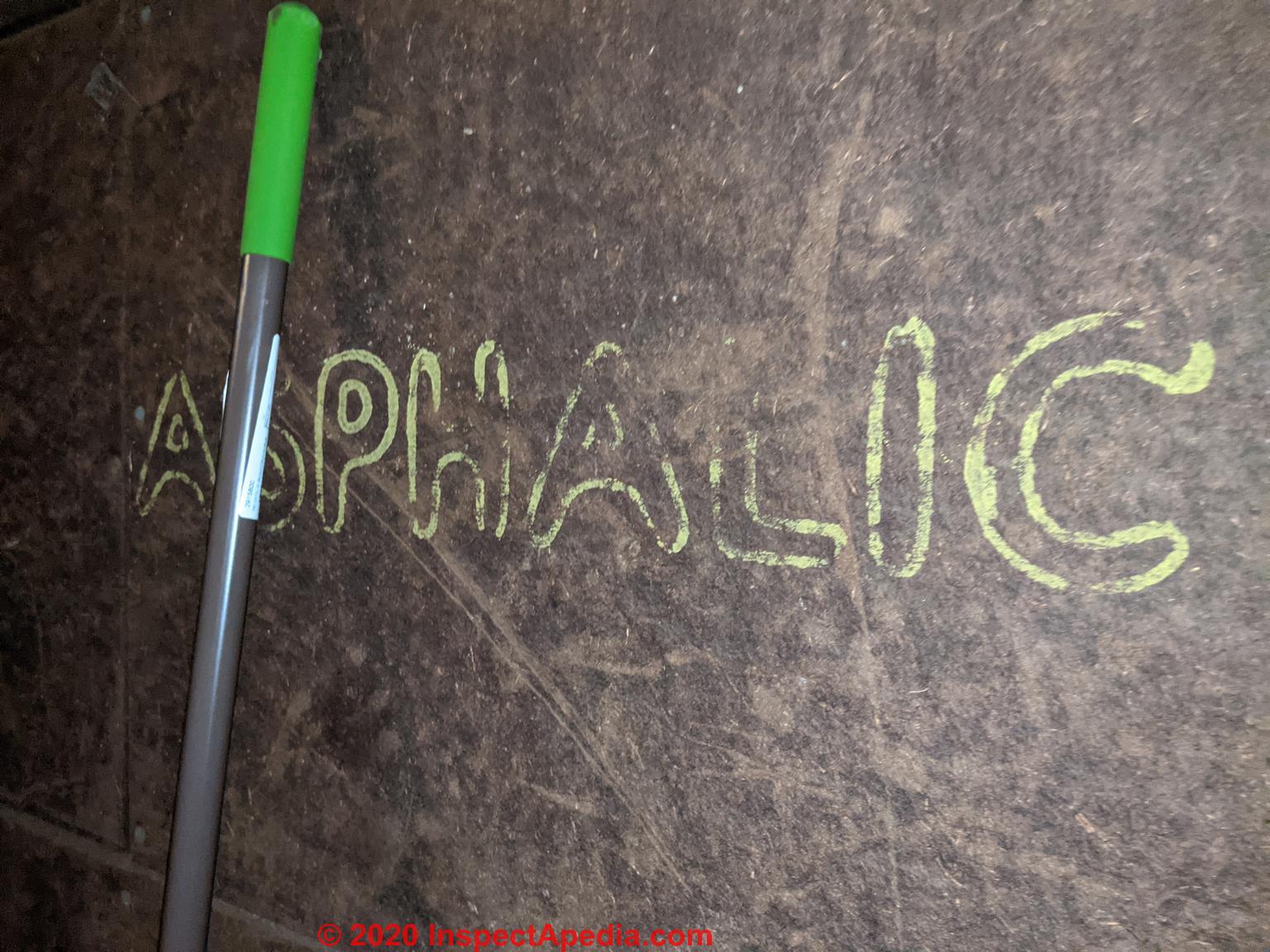 Gavin
Gavin
Thanks for the photo; I've not seen that ASPHALIC fiberboard label before.
I've tried to research the brand or product history searching for "Asphalic Fiberboard" and for "Asphalic Brand" fiberboard and for
"Asphalic fiberboard company" with no success
- most -likely because the search engines are determined to inform us that we have simply mis-spelled "Asphaltic" having typed the word without the "h".
I've found "Asphalic Concrete" and "Asphalic bond breaker" which would be a fiberboard product intended for use as a bond-breaker between a concrete pour and a concrete form.
I'll keep looking and meanwhile perhaps a reader will see your photo and help us out.
Meanwhile note that there are other quite a few asphalt-impregnated fiberboard sheathing products listed on this page and in other InspectApedia.com articles such as some of our Homasote and Celotex products.
Below is a modern asphalt impregnated fiberboard sold at Home Depot stores and described as
1/2 in. x 4 ft. x 8 ft. Southern Pine Asphalt Impregnated Board
and
Exterior fiberboard sheathing with interknit wood fibers that give the product on-the-job toughness
Helps supplement required wall bracing in traditional wall construction
Contributes extra insulation value
Absorbs sound Inhibits water intrusion and slows air infiltration - retrieved 2021/05/27 original source: https://www.homedepot.com/p/1-2-in-x-4-ft-x-8-ft-Southern-Pine-Asphalt-Impregnated-Board-A11230848096/206086210
for which the company provides this research article that does not address this specific product:
- Fournier, R., A. Ramirez, & S. Vargas, EVALUATION of PERFORMANCE PROPERTIES of ASPHALT-IMPREGNATED CORRUGATED SHEETS [PDF] (1991), 1991 International Symposium on Roofing Technology, pp. 180 - 188.
and which in our OPINION has nothing to do with insulating sheathing except that there are some common base materials including organic fibres and asphalt.
Is there Asbestos in Beaverboard?
Does Beaver Board contain asbestos? I am cleaning out my grandmothers home and her basement has a Beaverboard ceiling. The home is approximately 65 years old but not sure how long the tiles have been in the basement - 6/25/2014 Sara
Moderator reply: Sarah:
No, BEAVERBOARD is a wood fiber product not an asbestos-product.
See BEAVERBOARD Identification for details.
- R-Value of WOOD [Web page] U.S. Department of Energy
- [14] Standards pertaining to fiberboard insulating sheathing:
- ASTM C 208-95 (2001) – Standard Specification for Cellulosic Fiber Insulating Board. Type IV Grade 2 (Structural Wall Sheathing).
- ASTM C 846-94 (2003) – Application of Cellulosic Fiber Insulating Board for Wall Sheathing.
- ASTM D 1554 - Definitions of terms Relating to Wood Based Fiber and Particle Panel Materials.
- ASTM E-72 (1997)- Standard Method for Conducting Strength Tests of Panels for Building Construction.
- ANSI /AHA - A194.1, Cellulosic Fiberboard.
- U.S. Department of Commerce: PS57-73, Cellulosic Fiber Insulating Board
- A.F.A. (2003): Fiberboard Sheathing test results
Does Blackboard sheathing, fiberboard, Homasote, Celotex dark or black insulating board contain asbestos?
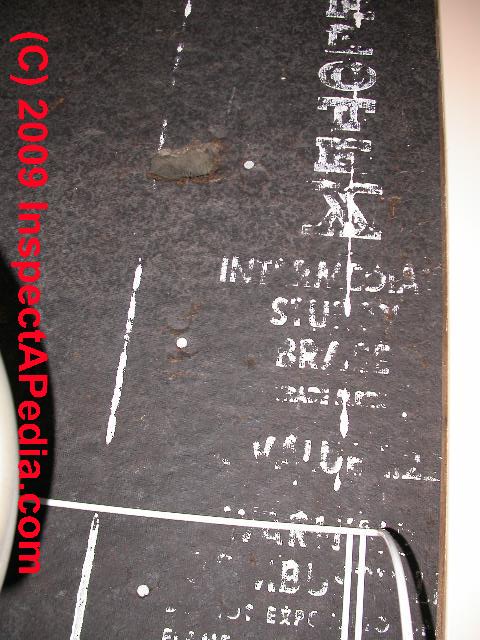 Photo: Celotex asphalt-impregnated (for moisture resistance) wood fibeboard may be black in color as were fiberboard products by other manufacturers.
Photo: Celotex asphalt-impregnated (for moisture resistance) wood fibeboard may be black in color as were fiberboard products by other manufacturers.
Reader Question: Could my Georgia Pacific regular sheathing PS 57 and ASTM C 208 black board fiberboard sheathed house contain asbestos?
i live in a BISF house the interior walls are some kind of board they look like fibre board and are a light brown some are more grey..could they contain asbestos? - (Dec 15, 2012) Lisa
Doing some remodeling and we found this under the drywall - Georgia Pacific regular sheathing PS 57 and ASTM C 208 black board.
Do you know if this product contains asbestos or a wood product? - (Aug 8, 2015) Sue S
Reply: Fiberboard sheathing is a wood product. It may be Black, Brown, Tan, or even White
Sue & Lisa:
Fiberboard sheathing is normally a cellulosic product - that is, made from wood fibers. Here is what Georgia Pacific says - retrieved today from their site:
Georgia-Pacific regular fiberboard sheathing is certified and labeled by an ICC-ES recognized agency as meeting the requirements in ASTM C208, the Standard Specification for Cellulosic Insulating Board.
Similarly, ASTM C 208 is a standard for cellulosic (wood fiber) boards from which we excerpt:
This specification covers the principal cellulosic fiber insulating board types, grades, and sizes. Insulating board covered by this specification consists of six types: Types I, II (Grades 1 and 2), III (Grades 1 and 2), IV (Grades 1 and 2), V, and VI.
Cellulosic fiber insulating board shall be manufactured from refined or partially refined ligno-cellulosic (wood or cane) fibers, by felting or molding process, into homogeneous panels. The insulating board shall conform to the physical properties specified.
Fiberboard panels are also constructed using hemp, as we illustrate above, touted by THC a hemp enthusiast magazine. As the article sports a silly pseudonym we haven't cited the author more directly. The magazine's email: info@thcmag.com
Also see CANEBOARD PANELS - separate article, and to identify this material
Reader Question: I am curious about the black board - what are the chances it contains asbestos?
Well I am curious about the black board? Our house was built in 1962 and I need to drill through the black board to run electrical! Some of it is super brittle and falling apart anyway.
Was any of that stuff made with asbestos? What are chances it has asbestos in it? - Brett 9/4/2011
I was tearing off parts an outside wall connected to the garage to add insulation to the wall, after removing the plywood and tar paper I ran into Celotex fiber/black board.
I have a picture of it to upload if at all possible, but what I can see is that it is black fiber board with Celotex in yellow writing with patent pend. underneath the logo.
The house was built in 1950 and I am concerned this product actually may contain asbestos. Is there any way you can confirm or deny this or point me in the right direction to find out. - Jon T. 11/5/2011
Reply: Asbestos is not an ingredient in fiberboard insulating sheathing. See the product description & MSDS information above
Brett and Jon: it's easy to drill through "black board" Homasote or Celotex type building insulating sheathing. Generally the product is made from wood fibers, not asbestos - See the insulating board MSDS data sheet quotations in the FAQ discussion just above.
Though I've heard rumor, not fact, claiming that some fiberboard insulating sheathing products contained asbestos, I have been unable to find an authoritative source that confirmed that worry for any of those products.
Take a look at the insulating board MSDS data in the FAQ above about yard mulch and you'll see clear statements from the manufacturers on this matter.
Reader comment:
I only have to drill small hole to run wiring! Some of it's already crumbling and brittle! It's black on outside looks like wood inside. I too have not been able to find anything confirming or not confirming this concern! I'm stuck with new electrical to run and deciding if this is health issue or or not. Thank you again - Brett
Reply:
Sounds as if the risk is nil, Brett. In addition to the comment we made above (wood fibers are not asbestos), you can minimize dust release by moistening the drilling area a bit. It's unlikely that there would be a measurable hazard from drilling a single wire-sized hole.
Too, if you have a generic objection to even small amounts of dust from any building material, you have the option of HEPA vacuuming during and after drilling to keep the dust out of the air.
See IDENTIFY Celotex® Insulating Board and Fiberboard Products
Fir-Tex, FirTex, Fire-Tex Fiberboard - Kaiser Gypsum
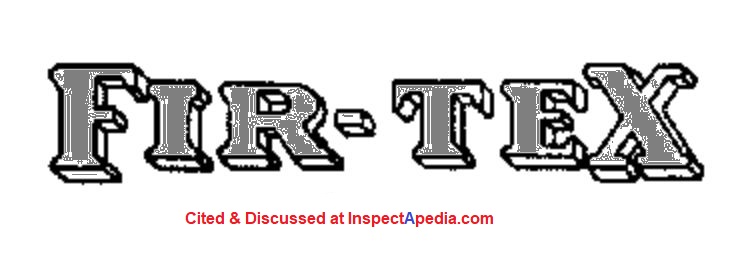 Fir-Tex, in some literature FirTex or Fire-Tex or FireTex was a fiberboard product, made principally of wood pulp and was produced by the Fir-Tex Insulating Board Co., an Oregon corporation operating at St. Helens, Oregon, engaged in the manufacture of insulating wall board from at least the mid 1930s.
Fir-Tex, in some literature FirTex or Fire-Tex or FireTex was a fiberboard product, made principally of wood pulp and was produced by the Fir-Tex Insulating Board Co., an Oregon corporation operating at St. Helens, Oregon, engaged in the manufacture of insulating wall board from at least the mid 1930s.
Note that asbestos, Asbestos, plaster of Paris, clay, turpentine, paraffin wax, or other materials were added to some mixes to improve fire resistance and produce other desirable qualities such as stiffness, hardness, smooth surfaces, increased strength, or durability. (Wilson 2007)
The trademark was associated with / registered by Kaiser Gypsum Co. - 1958-06-10.
The trademark category description includes
Composition wood fiberboard, insulating sheathing, roofdeck materials, insulating tile, building board, utility board, insulating plank, and acoustical tile
International Class
017 - Rubber, gutta-percha, gum, asbestos, mica and goods made from these materials and not included in other classes; plastics in extruded form for use in manufacture; packing, stopping and insulating materials; flexible pipes, not of metal.
019 - Building materials (non-metallic); non-metallic rigid pipes for building; asphalt, pitch and bitumen; non-metallic transportable buildings; monuments, not of metal.
- Rubber, gutta-percha, gum, asbestos, mica and goods made from these materials and not included in other classes; plastics in extruded form for use in manufacture; packing, stopping and insulating materials; flexible pipes, not of metal.
Building materials (non-metallic); non-metallic rigid pipes for building; asphalt, pitch and bitumen; non-metallic transportable buildings; monuments, not of metal.
See details
at IDENTIFY Fir-Tex Firtex Firetex Insulating board
GP QuietBrace Structural Sheathing Properties
Quietbrace® is a high-density fiberboard panel produced by Georgia Pacific, made from wood or cellulose fibres including recycled materials, and providing both structural bracing and insulating and sound-deadening properties in an exterior wall sheathing product.
See this
- GP QUIETBRACE SHEATHING SPECIFICATIONS SHEET [PDF] Georgia-Pacific Wood Products LLC
133 Peachtree Street, N.E. | Atlanta, GA 30303 | 1-800-231-6060 | www.buildgp.com retrieved 2021/05/27 original source: Home Depot https://images.homedepot-static.com/catalog/pdfImages/95/958dd23e-8bdf-4340-a701-61b855d9c5df.pdf
Excerpt Produced with a high percentage of regionally sourced, recycled fiber content, QuietBrace provides strong construction characteristics and valuable environmental contributions as well as material cost efficiency and stability - GP, REGULAR FIBERBOARD SHEATHING INSTALLATION INSTRUCTIONS [PDF] [copy requested - avoid archiexpo [dot] com spammer]
Is this a brown insulation board? I worry that it contains asbestos.
Reader Question: does the brown insulating board found under bowling alley lane material contain asbestos?
I am writing to you because I found your website after realizing I may have been handling asbestos-containing materials for the past year or so without knowing.
I don't know how it didn't occur to me sooner, but now I'm really scared and don't know where to turn for help.
I'm a teacher in NYC and, unrelated to my teaching, about a year ago I started working with old bowling lane flooring.
 On the underside of bowling lane floors there is a fiberboard type material I believed was used for sound dampening.
On the underside of bowling lane floors there is a fiberboard type material I believed was used for sound dampening.
I've handled and ripped off this material so many times without once thinking what it was- I think I was told it was Homasote and harmless.
Since many of these bowling lanes were installed many years ago, it worried me even more. Now I'm not so sure what it is and scared at the thought of what it could be.
I've spent the last few hours panicked at the computer searching for information, trying not to show my wife how scared I am.
If there is any way you could call me or share any information, I would be so grateful.
Your website seems like the work of a very knowledgeable expert in this area so I'm turning to you for some advice. Attached below is a photo of some of the material- it is the black strips of material stapled to the black underside of the wooden board on the left.
Again, thank you in advance for any information you can offer. Feel free to call any time of day or night.
Thank you for taking the time to speak with me yesterday. I really appreciate your advice and insight into my situation. I attached a link below to a bunch of photos of this material that was attached to the back of three different pieces of the bowling lane.
There are just strips of this material attached with staples to the underside every few feet of the bowling lane. Some is black on the outside, some is white, and some is just like a brown cardboard color-- it all looks fairly similar on the inside.
If you can let me know what you think ASAP, that would be great- I know you told me not to be, but I am really worried about all this- I've been a mess all week at school.
Also, if you have those names or contact info for anyone who might be willing to test this material for me, that would also be incredibly helpful. I can't thank you enough for your help with this- feel free to call or email me back with any information. - A.S. 11/5/2013
Reply: The material looks like and probably is a wood fiber insulating board - not asbestos-containing. But protect yourself from demolition dust.
 The material I can see in your online photos is almost certainly wood fiber based Homasote type insulating board. That is not an asbestos product. You can see more examples of this product
The material I can see in your online photos is almost certainly wood fiber based Homasote type insulating board. That is not an asbestos product. You can see more examples of this product
If nevertheless you want to have as sample of the material tested for asbestos content, the cost is usually minor - about $50. U.S. You can use any certified asbestos testing laboratory - and can find one via help given
As we discussed by telephone, you should, however protect yourself from breathing dust during any demolition project.
While the material you are working with was sandwiched between other building materials: bowling alley lane surfacing and the subflooring atop the floor structure - a location where it was rather protected unless the building flooded.
In that location I speculate the material would be less likely to be contaminated by other exposures.
Nevertheless, breathing high levels fine dust particles that can be released into the air by the disassembly or demolishing of building is a health risk.
Ultra fine particles, down in the 1u range are probably low in dust from fiberboard sheathing, but of course I don't know what else is in the environment where you are working.
To be ultra safe while working you'd wear a HEPA-rated dust mask. At a very minimum I recommend you wear a paper N-95 dust mask as well as other appropriate protection (eyes, hands) when disassembling and demolishing these materials.
If you decide to have a section of the material tested for asbestos, I would choose a piece of the insulating board that has that white skin or coating - to check that those products were not made with a facing of asbestos paper.
The history of fiberboard insulating products is interesting in that while the product itself is not an asbestos-based material, there were some questions of cross contamination with asbestos because of the manufacturing location of some brands.
However to date, except for Kollman (1975) I have not found scholarly studies nor other information that confirmed that wood fiberboard based insulating board did actually contain asbestos.
Also see FIBERBOARD SHEATHING IDENTIFICATION
Reader Question: I was worried it contains asbestos but just looks too dark to be to me
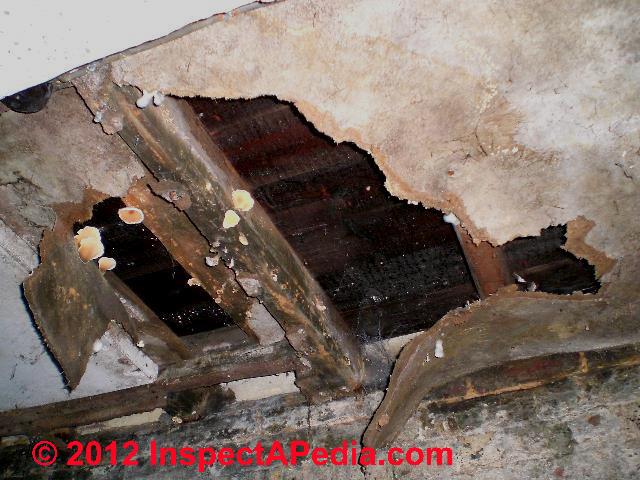 I know you guys know a lot about asbestos containing products and just wanted advice on a wood like fibre board I found in a cellar, I was worried it contains asbestos but just looks too dark to be to me and more like other wood fibre boards you discuss on your website.
I know you guys know a lot about asbestos containing products and just wanted advice on a wood like fibre board I found in a cellar, I was worried it contains asbestos but just looks too dark to be to me and more like other wood fibre boards you discuss on your website.
Any views would be appreciated. Picture attached! (feel free to republish as you like). - B.K. 06/29/2012
Reply:
A competent onsite inspection by an expert usually finds additional clues that help accurately diagnose a problem - in the case of your photo it looks as if that area has been quite wet for some time - nice mushrooms growing - watch out for rotted ceiling joists or rafters.
It appears that the original ceiling was a brown fiberboard product that was later covered by drywall - visible in the left side of your picture. Your home is an old one - the roof sheathing boards visible where the ceiling has collapsed in from leaks were cut with a machine-operated pit saw.
Depending on the building's location, that could be a structure built before 1900.
Fiberboard products have been around in the U.S. since about 1858, though they were not widely used until the 1940's.
The brownboard in your (not so sharp) photo looks to me like a wood fiber product.
Depending on the age of the building and its location (in the U.S. ?) that ceiling could have been originally installed using an insulating fiberboard from any of fourteen manufacturers, so there are indeed variations in both original color, and in color after wetting and age.
Can you tell me the thickness of the material? Insulating fiberboard's were usually 15/32" thick, with a few 1/2" thick; Hardboard such as some Masonite products can be 1/4? or thinner, and are hard. In your photo the board looks thicker than that, but the way it is tearing left me to consider a hardboard product.
I'd be glad for you to send me about 2 sq. in. in a clean ziplok bag, so that I can examine it in the lab (pro-bono, no fee). Unfortunately though I won't be able to examine it closely until our lab returns to the U.S. in January.
Does Gold Bond Insulating Board (IB) Contain Asbestos?
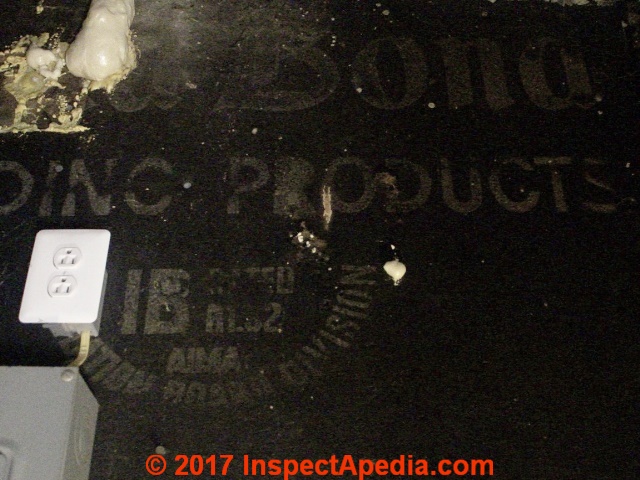 Reader question: does this Gold Bond brown or black insulating board contain asbestos?
Reader question: does this Gold Bond brown or black insulating board contain asbestos?
These photos are of insulating board found n the electric cupboard.
I would appreciate any feedback on this board, I'd not really noticed it until the renovations when I'd started seeing articles on building materials , but now I've realized it's exposed in the door well and my son has been crawling around there I'm pretty worried!
Many thanks - Anonymous by private email 2017/09/19
Reply: Probably not
Wood-based or cellulose-based insulating board like the product we show here would not be expected to contain asbestos unless by accidental cross-contamination by having been made at the same location where asbestos products were being manufactured.
The Gold Bond IB shown above looks like a wood-fibre based insulating board, typically covered with an asphalt or wax coating to improve its moisture resistance.
It should not be shedding much material of any kind unless it's being sawn or chopped or demolished.
I note the brown wood fibers where the black coating has been lost or worn away (red arrow in photo just above) where I see light material between two insulating board panels I am guessing that is the surface of a stud or of some other material.
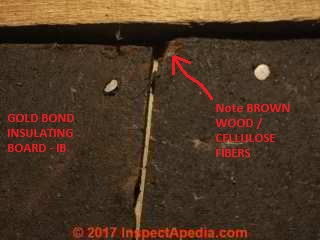 However at ASBESTOS PRODUCING COMPANIES & TRUSTS where you will find National Gypsum in that alphabetic list, we discuss a number of Gold Bond™ products, all produced by National Gypsum, that did indeed contain asbestos.
However at ASBESTOS PRODUCING COMPANIES & TRUSTS where you will find National Gypsum in that alphabetic list, we discuss a number of Gold Bond™ products, all produced by National Gypsum, that did indeed contain asbestos.
Those were principally gypsum-based or cement-asbestos based materials.
National Gypsum, who made Gold Bond products, did produce other asbestos-containing gypsum based (plasterboard) products and also asbestos-containing cement-board products as well as other asbestos products such as some coatings.
See IDENTIFY National Gypsum Gold Bond® Brand Insulating Board
General information about wood or cellulose based insulating board products is
The use of asbestos in gypsum panels or "drywall" panels (plasterboard) is discussed
at ASBESTOS in DRYWALL and also
Reader follow-up: plan to test Gold Bond insulating board for asbestos
Very much appreciate the info! It is comforting to know it is wood based, I have been worrying since I saw that big Gold Bond logo on it and Googled the company. I actually sent a sample off to pro lab to be tested yesterday so I will update you when I get the results, perhaps it will reassure another of your readers.
I couldn't find much info on their insulation board online. In the door well on the same wall. I had mentioned there are several layers of exposed drywall/plasterboard (I'm assuming), likely old, so I will definitely treat that with caution, and look into it before demolition.
Again, thank you for the info and I'll keep you updated! - Anon 2017/09/21
Reader follow-up: results of lab-test for asbestos in Gold Bond fiberboard sheathing - negative
2017/12/06 reader anon updated us on the tests she had performed for asbestos content in Gold Bond brand fiberboard.
... sorry I am so long getting back to you! Lab results came back as 90% cellulose and 10% Bitumen, a relief! Thanks for your help with this, - Anonymous by private email
How to Distinguish Cellulose or Fiberboard IB from Plaster or Gypsum or Cement-Board Products that are More-Likely to Contain Asbestos
To distinguish between gypsum-based or plaster-based panels or cement-asbestos panels that may have contained asbestos (or are known to have contained asbestos) and cellulose or wood fiber board, look for a hard white or gray core in your insulating board or sheathing board panels.
If your panels are brown or tan cellulose-like fibers throughout, often with a waxy or dark asphalt surface coating (added for water resistance) those are a cellulose product, not a plaster or asbestos cement product.
See FIBERBOARD SHEATHING INGREDIENTS and
see FIBERBOARD SHEATHING MSDS about the ingredients or constituents of fiberboard sheathing products.
See SHEATHING, GYPSUM BOARD for a separate description of gypsum or plaster based wall sheathing board.
Graylite Board Asbestos?
Graylite Board Asbestos?
See details Graylite
at IDENTIFY INSULITE, or GRAYLITE BOARD PRODUCTS
Excerpt:
Insulite [and we think Graylite] ingredients included a composition of plaster of paris, cement, or other like substance, combined with hair, wood fiber, sawdust, wool, wood shavings, excelsior, straw, or similar substances. (Asbestos was not cited in the product description. )[11]
Does or Did Homasote® Contain Asbestos
No, not according to the company nor in research that we cite at the Homasote® article given just below.
Homasote® company history, current product list, product composition & contact information are
at HOMASOTE HISTORY & PRODUCTS
Insulite Board Asbestos?
See details about Insulite
at IDENTIFY INSULITE, or GRAYLITE BOARD PRODUCTS
Excerpt:
Insulite ingredients included a composition of plaster of paris, cement, or other like substance, combined with hair, wood fiber, sawdust, wool, wood shavings, excelsior, straw, or similar substances. (Asbestos was not cited in the product description. )[11]
Asbestos in Low Density Board (LDB) "Fiberboard" Products
 Some low density fiberboard products like those described here were widely manufactured and distributed including in the U.K. and Australia; these products are particularly hazardous if disturbed as they are soft and they contain high levels of asbestos.
Some low density fiberboard products like those described here were widely manufactured and distributed including in the U.K. and Australia; these products are particularly hazardous if disturbed as they are soft and they contain high levels of asbestos.
These board products are visibly different in colour (whitish gray throughout) than cellulose-based or plant-fibre-based fiberboard products (tan or brown in colour).
Asbestos-based LDB or LDF looks like its more cementious asbestos cement board, and is similar in colour, but unlike asbestos cement board, low density asbestos fiberboard is soft-enough to be easily broken by hand, as you can see in the photo shown here - courtesy Queensland AU government, cited below.
Asbestos LDB, when broken, shows more fibres than broken asbestos cement board, and it is also lighter in color as you'll note in the Queensland photo shown here.
For example, Asbestoslux and Duralux LDB sold un Australia in the 1950s was an asbestos product.
LDB was manufactured from the 1950s to the 1970s as flat and perforated sheet products and was used for wall and ceiling panels, thermal and acoustic insulation, fire protection and for general building work in industrial and commercial buildings, education facilities and domestic premises.
It was sold under product names such as ‘Asbestolux’ and ‘Duralux’ and is unlikely to be found in buildings constructed after 1982.
Asbestos LDB products were made in a variety of forms and thicknesses including insulating board, pre-beveled ceiling and wall panels (shown below), and even pegboard, also shown below.
James Hardie manufactured LDB as a material with the asbestos bonded to a calcium silicate. This material had brand names of 'Asbestolux' and 'Duralux'.
Both were manufactured in thicknesses of 4.5mm, 6.5mm, 9.0mm and 12mm and they had either a bevelled, square edge or a recessed edge for flush jointing. (the jointing cement was also manufactured with asbestos).
LDB was manufactured as flat sheets and with perforations to assist with noise attenuation. - Queensland AU, cited below.
- Anderson, P. H., and W. J. Farino. ANALYSIS of ASBESTOS FIBER RELEASE FROM CERTAIN PRODUCTS [PDF] (1982) U.S. Environmental Protection Agency, Office of Toxic Substances 68-01 (1982): 5960.
- Queensland Workplace Health & Safety, LOW DENSITY ASBESTOS FIBERBOARD [PDF] Queensland Government, Queensland, Australia, Web: https://www.qld.gov.au or https://worksafe.qld.gov.au Tel: Within Australia: 13 QGOV (13 74 68)
International callers: +61 7 3328 4811 (+10 hours UTC), retrieved 2021/0825, original source: https://www.asbestos.qld.gov.au/general-information/low-density-asbestos-fibre-board
Queensland providesd a series of "how to" articles for dealing with asbestos LDB, such as handling the material, drilling and cutting, and making minor repairs. Find those at the website we cited just above, and in examples we include just below. - Queensland Workplace Health & Safety, IDENTIFYING AND HANDLING LOW DENSITY ASBESTOS FIBRE BOARD (LDB) [PDF] (2021) Queensland Government, Australia, Op. Cit.
- Queensland WHS, GUIDE to IDENTIFYING & HANDLING LOW DENSITY ASBESTOS FIBERBOARD [PDF] (2015) Op. Cit.
Excerpt:
LDB is a lightly compressed board containing asbestos fibres in a calcium silicate plaster. It is sometimes referred to as asbestos insulating board.
LDB can contain up to 70 per cent asbestos fibres by volume. Asbestos cement sheeting typically contains between five to 20 per cent asbestos.
LDB was manufactured from the 1950s to the 1970s as a flat sheet, or perforated sheeting product typically used for acoustic ceiling applications.
More photos of LDB or LDF Asbestos board from the Queensland photo gallery are examples from the Queensland source cited below.
Notice that this LDB "Pegboard" is perforated with holes in staggered rows; in contrast, pegboard made of wood or plant fibers such as the Masonite pegboard shown for comparison, has holes that are in regular rows, not staggered, and of course Masonite is brown, not gray-white, and as an HDF product, it's notably harder.
- Queensland Government, Asbestos LDB photo gallery, source of photos shown here, retrieved 2021/-8/25 original source: https://www.asbestos.qld.gov.au/general-information/low-density-asbestos-fibre-board/low-density-board-photo-gallery
- Queensland WHS, ASBESTOS LOW DENSITY FIBERBOARD [PDF] (2009) Op. Cit.
- Queensland WHS, HOW TO SAFELY REMOVE ASBESTOS [PDF] Op. Cit.
- Rhiger, Hans. THE FIBER BOARD INDUSTRY [PDF] (1937). BSc Thesis, Oregon State Agricultural College (June 1937)
Includes a description of Fir-Tex (pp 20-23) and also notes that asbestos was among ingredients in some fiber board products.
Excerpts:
In a survey of patent literature relating to boards consisting of a single layer there are listed 57 patents together with 22 relating to lath boards. There are already fifteen commercially important insulating boards manufactured wholly or in large part by wood fiber.
Many of these are widely advertised and have come into extensive use. The insulating material industry was born about 19 years ago.
The first board was such a success that in the last few years more than a dozen similar products appeared on the market. In general, the manufacture of fiber building boards from wood has assumed a great diversity in nature and form of products.
...
from other sources are now utilized, particularly in the insulating types of boards. These fibers are obtained from extracted sugar cane, sawmill waste, straws, cornstalks, grasses, extracted licorice roots, tobacco stems, waste papers, bark, flax, cotton stalks, palmetto, asbestos, oat hulls, cottonseed hifi s, rye straws, and other similar vegetable materials.
Do Nu-Wood Sta-Rite Cellulose Board Products or Ceiling Tiles Contain Asbestos?
Asbestos in Nu-Wood Stay-Lite cellulose fiber ceiling tiles ?
I've been poking around the net trying to find out about tiles in a 1960 Maine lake house that fortunately still has the box in the attic Nu-Wood Stay-Lite cellulose fiber ceiling tiles 40-004 class d - 2015/11/30 Leslie
This question was posted originally
at ASBESTOS CEILING TILE IDENTIFICATION
Has asbestos ever been found in the old Nuy-Wood fiberboard ceiling board material in the U.S. ?
Has asbestos ever been found in the old fiberboard ceiling board material in the U.S. ? Mine is not tiles but a smoothe painted board for the ceiling
OK sorry i didnt explain better but i know its not an ingredient in fiberboard but i mean has it ever been found by being cross contaminated and if so like how common and im also in the united states if that matters - On 2021-12-24 by sue thomas -
Reply by Inspectapedia Com Moderator
@sue thomas and @ Leslie:
Asbestos by cross-contamination is a topic we cite eleven times in the article SHEATHING, FIBERBOARD ASBESTOS CONTENTWe've looked at the question repeatedly and in general found a possibility of asbestos in wood fiber based ceiling tiles and possibly in ceiling board products like yours. Below you'll find the supporting research.
Here is from our article that I named just above, a most-useful comment on this question:
For some of these wood-based or cellulose products, cross contamination with asbestos did occur.
It is noteworthy that these products indeed included some ceiling products and installations as the U.S. Forest Products lab has documented, illustrating a fiberboard ceiling in a ranger station. Excerpting from the US FPL document cited below we include that image here:
Fiberboard ceiling panel, US FPL excerpted from www.fs.fed.us/t-d/pubs/htmlpubs/htm07732308/However a number of asbestos and mesothelioma information sources point out that some fabrication plants that at one time processed asbestos materials also processed wood-fiber products and thus there were hazards of cross-contamination and worker exposure to asbestos in those locations.
A new Google Scholar search for "asbestos in fiberboard" in 2021 found additional articles that combine those terms, though you must read with care to be sure the article isn't discussing asbestos-cement products: a different product line.
Examples of those research results are included atASBESTOS in FIBERBOARD - RESEARCH
So was NuWood Fiberboard cross-contaminated by asbestos?
@Inspectapedia Com Moderator, ok so are you saying that the nu wood fiberboard has actually been found that some of it has been cross contaminated? - On 2021-12-26 by sue thomas -
Reply: cellulose (used board products and some ceiling tiles) is a wood or plant fiber, not asbestos but there were asbestos warnings for workers at Nuwood processing mills.
The research we found and that we've cited here describs possible exposure of workers in the fiberboard plant to airborne asbestos. US FPL cites use of asbestos in some ceiling tiles as well.
Shown here: Nu-Wood products catalog pages from 1936.
Leslie, the Sta-Lite cellulose ceiling tile photo that you posted is self-described as a 12" x 24" painted-bevel cellulose product #40-004 - that's wood fibers not asbestos. These products are classified as low-density fiberboard. Quoting the U.S. FPL,
Fiberboard is a generic name for construction panels made of wood or vegetable fibers. (Wilson 2007).
Here is how the manufacturer itself described Nu-Wood panels:
Made of clean wood fiber, this new wall and ceiling treatment consists of specially designed and accurately fitting tile, plank and wainscot units, in large, easy-to-handle sheets. A high degree of insulation value is built into these Nu-Wood products.
The image you contributed will be added here to assist other readers and to invite further comment that may give us more information. Thank you.
I'd be grateful if you'd take another look at the box for any other labels or markings. Please also use our page bottom CONTACT link to email photos of both sides of the ceiling tiles themselves as well as an installed ceiling if one is present in your home.
Nu-Wood is described by the U.S. Forest Service Technology & Development Program as a cellulose (wood-based) fiberboard product that was produced as early as 1938 including brand names Masonite, Nu-Wood, Du-X and Fir-Tex.
Those early products were not ceiling tiles but rather wood-fiber hardboard or softboard sheets used as a finish material or as a lath or base for plaster walls and ceilings.
Related products included other familiar brand names beaverboard, caneboard, Celotex, Homasote, Insulite, Masonite, Gold Bond, National Gypsum, Nu-Wood, and Upson Board are described by links given at the MORE READING section of this article.
These include principally wood-based or cellulose or plant-based products not asbestos products except for plaster or gypsum based wall sheathing.
However for some of these wood-based or cellulose products, cross contamination with asbestos did occur. See our NU-WOOD discussion just below for an example.
Asbestos in Ceiling Tiles made by Conwed (Wood Conversion Company) in Cloquet MN: 1958 - 1974
It is noteworthy that these products indeed included some ceiling products and installations as the U.S. Forest Products lab has documented, illustrating a fiberboard ceiling in a ranger station. Excerpting from the US FPL document cited below we include that image here:
However a number of asbestos and mesothelioma information sources point out that some fabrication plants that at one time processed asbestos materials also processed wood-fiber products and thus there were hazards of cross-contamination and worker exposure to asbestos in those locations.
None of those references that I have read (this is not an exhaustive research) confirmed asbestos hazards in the cellulose products themselves, even though such is technically possible. An example follows:
Watch out: further research is needed to confirm the relationship between Nuwood and Nu-Wood ceiling products but we have found a warning issued by the Minnesota State Health Department cautioning that workers were exposed to airborne asbestos fibers when working in three Nuwood production areas at the Cloquet plant in Minnesota between 1958 and 1974.
Excerpts and the document reference are given below.
Asbestos was used at the Conwed Corporation (Wood Conversion Company) plant in Cloquet, Minnesota, in making ceiling tiles and other products from 1958 through 1974.
Mixing, sawing, grinding, and other processes used in making these products created asbestos-containing dusts that were inhaled by many workers.
This is how most workers were exposed to asbestos.
Asbestos was used at the Cloquet plant in the manufacturing process during the years 1958-1974, and this is when the greatest number of workers were exposed. It is possible, however, that some workers were exposed to asbestos outside this time period.
For example, workers involved with maintenance and repair of equipment that had asbestos insulation, such as steam pipes and boilers, may have been exposed to asbestos before or after this time period.
We do not have information on actual levels of asbestos in the plant air. Asbestos dust levels probably varied at different locations and at different times. Overall, people who worked in the following departments probably had more exposure to asbestos than other workers:
- Nuwood Board Mill
- Nuwood Finishing
- Nuwood Shipping
- Balsam Wool Pump Mill
- Lo Tone
- Maintenance and Repairs
People who worked in the dustiest jobs for the longest periods of time would have had the most exposure to asbestos.
Anyone who worked at Conwed's Cloquet plant at any time during the years 1958-1974 may have been exposed to asbestos-containing dusts. Company records and other sources of information show that nearly 6,000 workers were employed for some period of time during those years.
The Minnesota Department of Health has been working for several years to identify and locate all former Conwed workers employed during those years.
Several types of asbestos from different suppliers were used at different times at Conwed during the 1958-1974 time period. Although all types of asbestos can cause asbestosis and lung cancer, the risk of mesothelioma may depend on the type of asbestos.
Conwed has not provided the State with information about the types and amounts of asbestos used during different years.
Most workers wore their work clothes home or took them home for washing. Asbestos-containing dusts could have been carried into the home on the workers' clothing, shoes, or hair.
Any exposure to family members in the home would be small compared to exposures in the plant. The risk of disease from these household exposures would be very small.
Watch out: Court documents assert that some Conwed ceiling tiles and/or some Simpson ceiling tiles and other products contained asbestos. (Wagner v. Bondex, Simpson, & Conwed, 2012)
See SIMPSON CEILING TILES for details.
Research: Asbestos found in Nu-Wood, Wood Conversion Company, Bondex, Simpson Timber products
- Minnesota Department of Health, "INFORMATION SHEET FOR FORMER CONWED WORKERS", [PDF] September 1993, retrieved 2015/12/04, original source: http://www.health.state.mn.us/divs/hpcd/cdee/occhealth/conwedfact.html
- Wagner & Wagner v. Bondex, Simpson, Conwed, Missouri Court of Appeals, Western District, WD72474 & WD72619, 19 June 2012, retrieved 2015/12/04, original source: http://www.courts.mo.gov/file.jsp?id=54841,
Full title: LOIS J. WAGNER, ROBIN G. ) WAGNER and WENDE L. WAGNER, Individually and as Wrongful Death Beneficiaries of ROBERT WAGNER, Appellant-Respondent, v. BONDEX INTERNATIONAL, INC., and SIMPSON TIMBER COMPANY, Respondent-Appellant, CONWED CORPORATION, Defendant, WD7274 (Consolidated with WD72619)
Opinion filed: June 19, 2012, Missouri Court of Appeals, Western District, APPEAL FROM THE CIRCUIT COURT OF CLAY COUNTY, MISSOURI The Honorable Kathryn E. Davis, Judge Before Division Four: Lisa White Hardwick, Chief Judge, Presiding, Joseph M. Ellis, Judge and Victor C. Howard, Judge.
Excerpts:
Bondex International, Inc. and Simpson Timber Company appeal from a judgment of the Circuit Court of Clay County entered in favor of Lois, Robin, and Wende Wagner, the wrongful death beneficiaries of Robert Wagner, in the amount $4.5 million.
Lois, Robin, and Wende Wagner cross-appeal that same judgment being reduced by 2 $900,000.00 pursuant to § 537.060.1 For the following reasons, the judgment is affirmed in part and reversed and remanded in part.
In 2006, Robert Wagner was diagnosed with mesothelioma, a cancer that affects the pleural lining of the lungs. During the 1960s and 1970s, Wagner worked as a carpenter installing ceiling tile at project sites in the Kansas City area. Wagner worked primarily for two companies during that time period, Kansas City Natural Slate and United Acoustics.
In 2007, Wagner died from mesothelioma, and his wife and children ("Plaintiffs") brought this wrongful death action. Plaintiffs claimed that Wagner's mesothelioma resulted from exposure to the asbestos-containing products manufactured by Bondex and Simpson Timber ("Defendants").
Bondex manufactured a joint compound that was commonly used on construction sites during the installation of drywall. From 1961 to 1977, Bondex joint compound contained asbestos.
Simpson Timber manufactured ceiling tiles. During the 1960s, Simpson Timber manufactured both asbestos-containing ceiling tile and non-asbestos-containing ceiling tile. Simpson Timber also purchased and resold ceiling tile from Conwed that contained asbestos. - Wilson, Rich, Kathleen Snodgrass, "EARLY 20TH-CENTURY BUILDING MATERIALS: FIBERBOARD AND PLYWOOD", [PDF] U.S. Forest Service, Technology & Development Program, March 2007, retrieved 2015/12/04, original source: http://www.fs.fed.us/t-d/pubs/htmlpubs/htm07732308/
- Wood Conversion Company, NU-WOOD INTERIORS FOR EVERY WALL AND CEILING [PDF] Wood Conversion Company, St. Paul Minnesota, (1936), retrieved 2015/12/04, original source: https://archive.org/stream/ Nu-woodInteriorsForEveryWallAndCeiling/ Nu-woodInteriorsForEveryWallAndCeiling_djvu.txt, This company was a producer of Balsam Wool & Nu-Wood, Nu-Wood Tile, Plank and Wainscot and similar products.
Coarse Random-Oriented Wood Strand Fiberboard
Question: are these asbestos-based panels?
I'm hoping you can tell me what these panels are and whether they have asbestos in them.
I've attached pictures. #143018 is a side view. #143034 is a corner that is damaged and gives a better view of the materials (shredded).
They were originally white but someone painted them grey.
Thanks so much for your help! - Anonymous by private email 2018/02/15
Reply: not likely
Without a lab analysis I cannot say absolutely that an unknown product is asbestos-free, but your photos look to me like a relatively modern wood product, a coarse, random-oriented wood- strand fiberboard product.
Above: wood fibre-reinforced cement board panels describe by the Architonic, a UK source of building products who insists on keeping the actual product manufacturer and identity a secret, Architonic ID: 1184351, prompting us to decline to cite the Archi tonic website directly.
This question and an answer are provided in more detail
at WOOD FIBRE INSULATING PANELS
Is there asbestos in this coarse wood fiber board used as roof sheathing?
Fibre board to the underside of roof tiles in 1968 detached bungalow. - On 2021-12-03 1 by David Blevings -
Reply by Inspectapedia Com Moderator (mod) - coarse stranded structural wood fiberboard identification
@David Blevings,
Thanks for the photo; that's a different sort of product using more-coarse stranded fibres and adhesives - in my view, somewhere between the fiberboard products shown above on this page and more-modern OSB.
If you ever spot a product name that would be valuable information to add.
See this nice article from the USFS in 2007 by Richa Wilson & Kathleen Snodgrass
We've added your photo at
WOOD FIBRE INSULATING PANELS [web article]
Take a look at that page where you'll find photos of similar products like the one we show above,
by the Architonic, a UK source of building products who insists on keeping the actual product manufacturer and identity a secret,
Renovation uncovered these boards, look like shredded paper: what is it?
Renovating the bathroom and uncovered these boards around the soil pipe. About an inch thick and looks like shredded paper that's been glued and pressed. Any idea what it is? - On 2022-02-28 by Asbestos? -
On 2022-02-28 by Inspectapedia Com Moderator (mod)
@Asbestos?,
That looks like a type of wood fiberboard.Probably it's a coarse wood fiber board that may have been used as sheathing, insulating board, or other applications.
See ARCHITONIC FIBROUS INSULATION BOARD - discussed just above,
or if it's a soft product
see FIBERBOARD SHEATHING IDENTIFICATION
Asbestos in Pionite & 1950s Furniture Hardboard?
Pionite was a line of laminate countertop materials bonded to a wood-fiber hardboard. The original Pionite brand dates from about 1946,
Above: a Pionite manufacturing stamp that we think indicates August 1953, found on the underside of a Pionate brand plastic laminated furniture top. Pionite was a product similar to the widely-known Formica brand plastic countertop laminate.
The Pionite plastic laminate veneer surface photo below, adapted from Pionite samples found for sale on Pinterist - Ed.
Possible asbestos in Pionite furniture top or in a backer-board product underneath? Ward Manufacturing Furniture Co. & Harmony House Furniture.
Hi, I have a few pieces of wooden mid-century modern furniture.
The tops are a Pionite material and the rest is either solid wood, veneer, or pressed fiber backing. I have looked all over the internet and have not found clear answers regarding the safety of either the backer boards or the underneath of the Pionite top.
Do you have any circumstances where you have found asbestos contained in these materials? Any guidance or wisdom on this topic would be greatly appreciated. - On 2021-12-21 by MVille -
Reply by Inspectapedia Com Moderator - Photos of Pionite plastic laminate countertop surface patterns
@MVille,
Thank you for the photos and the question. As you'll read in the article above, most fiber board does not contain asbestos. But I'm not familiar with the Pionite fiberboard product line and we'll do some research and post further findings here.
Any details you can add about country of location and age and brand of products where this fiberboard was used will be helpful.Pionite as a fiberboard product and a line of laminate countertop materials dates from about 1946, but if it's as suggested by your photos, a wood fibre product, then the advice on the page above still pertains.
The current Pionite company www.pionite.com was founded in 1999 - Pionite is a brand name of Panolam IndustriesTM, Inc. - so most-likely those folks will have little to say about your question.
The 1950s plastic laminate Pionite samples shown above were posted by a Pinterest reader but she offered no other informationFollowup by MVille - Fiberboard use in furniture from WARD Manufacturing and Furniture Co., Durham North Carolina, and from Harmony House Furniture (Sears).
@Inspectapedia Com Moderator, Thanks for the response.
One piece is stamped on the back "WARD Manufactoring Furniture Co." and another is from "Harmony House". After digging a bit I discovered Ward Furniture CO in Durham, NC is a private company established in 1948 and incorporated in North Carolina. They are still in business today.
Harmony House was a Sears home interior brand that started in the 1940s.
There were dates marked on the objects, but as you can see the stamping was not done well and the year is missing. Not sure if you are aware of any asbestos use by these two companies. I will try to contact Ward since they seem to still be in business. Thanks for your help.
Reply by Inspectapedia Com Moderator
@MVille,
Thank you, those added details will help our research and documentation.
On occasion, by including "Ward Furniture Co, and Durham, NC " and searching for patent disclosures in the 1940s, including perhaps 1940 - 1960, using Google Scholar often you can find a patent assignee that identifies Ward Furniture and a mention - or no mention - of asbestos in their products.
Reply by MVille - Ward Furniture Co. in North Carolina (retail distributor) claims no relationship with the original Ward Furniture Co. (Manufacturer)
@MVille, Well, after contacting the Ward Furniture Co. in NC, I was told they were primarily a retail distributor and have no relation to the mid-century manufacturer which must have gone out of business.
Asbestos in Simpson Sheathing, Underlayment, Board Products?
Getting ready to demo a structure with Simpson Insulation Sheathing - is there an Asbestos risk?
Thanks for the website - I'm getting ready to demo a structure with Simpson Insulation Sheathing and am more confident now about it not containing asbestos. On 2015-12-07 2 by Leslie W
Reply by (mod) - Yes, possibly.
Thanks for the feedback, Leslie.
If you can contribute some photos of the sheathing you're demo'ing, including any markings, please do so - use the page bottom CONTACT link. That may help other readers.
BTW some Simpson ceiling tiles and other Simpson products did tontain asbestos. (Source: (Wagner v. Bondex, Simpson, & Conwed, 2012)
- Wagner & Wagner v. Bondex, Simpson, Conwed, Missouri Court of Appeals, Western District, WD72474 & WD72619, 19 June 2012, retrieved 2015/12/04, original source: http://www.courts.mo.gov/file.jsp?id=54841,
Watch out: Court documents assert that some Simpson ceiling tiles and other products contained asbestos. (Wagner v. Bondex, Simpson, & Conwed, 2012)
Excerpt:
Simpson Timber manufactured ceiling tiles. During the 1960s, Simpson Timber manufactured both asbestos-containing ceiling tile and non-asbestos-containing ceiling tile. Simpson Timber also purchased and resold ceiling tile from Conwed that contained asbestos.
See SIMPSON CEILING TILES for details.
Daniel
Asbestos in TUF-FLAKE Flooring Underlayment Board?
Tuf-Flake Floor Underlayment,
I have Tuf-Flake Floor Underlayment, Mill 32 Type 1-8-1 with another number such as C8236-61 (can't clearly read it) used as underlayment for carpet in my home built in 1971. Is there a way to confirm that it does not contain asbestos?
Can't find any reference online.
Thank you for this site! Very helpful! - On 2016-10-11 by Dave Childs
-
Repy by (mod)
Above, for other readers, we show the Tuf-Flake Floor Underlayment identyification stamp.
We have not found any reports that this underlayment contained asbestos - no surprise as it's a wood fiber product.
References on Asbestos Contaminants in Fiberboard Insulation Products
Some interesting citations pertinent to the question include both articles and patents that we include in this article series.
- Altree-Williams, S., and J. S. Preston. "Asbestos and other fibre levels in buildings." Annals of Occupational Hygiene 29, no. 3 (1985): 357-363.
- Cadotte, John E. "Manufacture of mineral fiberboard." U.S. Patent 3,297,517, issued January 10, 1967.
- Cataldo, D. A., L. E. Schrader, and V. L. Youngs. "Analysis by Digestion and Colorimetric Assay of Total Nitrogen in Plant Tissues High in Nitrate 1." Crop Science 14, no. 6 (1974): 854-856.
Excerpt:
… The entire digestion apparatus rested on a sheet of 1.3-cm thick asbestos fiberboard to protect the laboratory bench. The digestion apparatus was tilted by raising the front of the hot … The base of the stand was covered with 0.65-cm asbestos fiberboard to protect the tube bottoms. … [Really? Possibly the authors are not using the term correctly - Ed.] - Collection, Wood. "Wastes into Wood: Composites Are Promising New Resource. [PDF] http://europepmc.org/articles/PMC1567208?pdf=render [copy on file]
- Coutts, Robert SP. "A review of Australian research into natural fibre cement composites." Cement and Concrete Composites 27, no. 5 (2005): 518-526.
[Possibly a significant citation & source of confusion about the asbestos content of wood-product fiberboard sheets because this text uses the term "asbestos fiberboard" as do some others - Ed.] - English, Brent. "Wastes into wood: composites are a promising new resource." Environmental Health Perspectives 102, no. 2 (1994): 168.
- Falk, Bob. "Wood-Framed Building Deconstruction." Forest Products Journal 52, no. 3 (2002): 9.
- Fowler, David W., James T. Houston, and F. B. Johnson. STRUCTURAL BEHAVIOR OF WALL PANELS FOR LOWER COST HOUSING (1972): 39. [PDF]
Excerpt:
… All panels except T10, with the relatively brittle as bestos-cement fiberboard on the tension side, deflected at least 2- 1/2 inches before … For the asbestos fiberboard the properties were: compressive and tensile moduli, 450, 000 psi and 613, 000 psi respectively; ultimate com …
In fact you'll see that the authors first discuss "Asbestos cement panels" (these are not a wood fibre product per se.)
It appears to me that some authors use the term "asbestos fiberboard" rather loosely, adding confusion to the topic.
Asbestos + cement is NOT a wood-fiberboard product like those discussed on this page. - Ince, Peter J., and David B. McKeever. Recovery of paper and wood for recycling: actual and potential. Vol. 88. US Department of Agriculture, Forest Service, Forest Products Laboratory, 1995.
- Ince, Peter J., and David B. McKeever. "Estimates of paper and wood recovery for recycling and potential for additional recovery in the United States." WOODFIBER plastic composites: virgin and recycled wood fiber and polymers for composites. Madison: Forest Products Society (1995): 144-154.
- Jamison, Danny G. "Method for using scrap rubber; scrap synthetic and textile material to create particle board products with desirable thermal and acoustical insulation values." U.S. Patent 5,439,735, issued August 8, 1995.
- Keer, J. G. "Performance of Non-Asbestos Fiber Cement Sheeting." Special Publication 124 (1990): 19-38.
Excerpt:
… to asbestos-cement is outlined. Typical tensile stress-strain curves of a number of alternative materials are compared with asbestos-cement. … The nonasbestos materials are generally much less brittle than asbestos-cement, although they have a lower first-cracking strength. The … - Kollmann, Franz FP, Edward W. Kuenzi, and Alfred J. Stamm. "Fiberboard." In Principles of Wood Science and Technology, pp. 551-672. Springer Berlin Heidelberg, 1975. Lundgren, S. Ake. "Hardboard as construction material—a viscoelastic substance." Holz als Roh-und Werkstoff 15, no. 1 (1957): 19-23.
This article refers to the occasional deliberate blending of asbestos with wood fiber products. Excerpt, p. 551:
Perhaps, the best factor for classifying fiberboard is the density. This is internationally recognized. There is a rather simple difference between pressed and not pressed sheets hut the range of qualities is wide and there is an overlapping.
Another point which should be taken into consideration is the fact that wood fibers are blended occassionally with mineral fibers (such as asbestos), plastics and with other chemical additives.
Some half-hard fiberboard contain no less than 20% of thermoplastic bonding agents.
- Copy available from various book vendors, also from Google Books, and at InspectApedia, on file, stored offline, as Principles-of-wood-science-and-technology-ii-wood-based-materials-Kollman.pdf - Nazerian, M., M. Kamyab, and H. Kermaniyan. "Application effect of mineral fibers on hydration and properties of gypsum-bonded fiberboard manufactured from kenaf and bagasse fibers." (2016): 203-228.
Excerpt:
… , asbestos and etc.) by organic-based fibers such as sisal, cellulosic fibers can be performed. … Hence, in this research the possibility of gypsum-bonded fiberboard production from … mechanical properties of gypsum-bonded fiberboard manufactured with gypsum to inorganic or … - Nozawa, Shuntaro, and Yosuke Komiyama. "Discovering the Depth of the Walls: Prefabricated Timber Houses in Interwar Japan." Architectural Theory Review (2021): 1-15.
Excerpt:
… geometry of a house from a regular arrangement of white, asbestos plates for the exterior. These outer walls were attached to a conventional, load-bearing timber framework, which was covered with a layer of fiberboard and asbestos plates forming the interior surface (fig. ). His … - Sebastien, P. M. A. G. A. G. J., M. A. Billon, G. Dufour, A. Gaudichet, G. Bonnaud, and J. Bignon. "Levels of asbestos air pollution in some environmental situations." Annals of the New York Academy of Sciences 330, no. 1 (1979): 401-415.
- Selikoff, Irving John, and Douglas HK Lee. Asbestos and disease. Academic Press, 1978.
- Stratton, J. C., and I. S. Walker. "Health and Safety Guide for Home Performance Contractors." (2012).
- Wise, Steve H. "Production of fiberboard containing mineral fiber." U.S. Patent 3,093,533, issued June 11, 1963.
Celotex Insulating Lumber & Celotex Blue Ridge: do these insulating board products contain asbestos?
Moved to
- CELOTEX BLUE RIDGE FIBERBOARD PRODUCTS - separate article
- CELOTEX INSULATING BOARD ASBESTOS CONTENT - separate article
Asbestos in FlintKote Insulating Sheathing Board?
Moved to FLINTKOTE Stalwart™ SHEATHING ASBESTOS
USG US Gypsum Sheathing Board Properties
Moved to USG US GYPSUM INSULATING SHEATHING ASBESTOS
Asbestos in USG Weatherwood Sheathing?
Weatherwood fiberboard insulating sheathing was tested for asbestos.
See details at
Also see
- USG SHEETROCK PYROFILL ROOF DECKS [PDF] - US Gypsum Insulating Pyrofill & USG Asbestos Board Pyrofill & USG Acoustical Pyrofill product descriptions, specifications, installation details, from USG 1952 Technical Specifications including:
USG Insulation Formboard is a rigid type wood fiber insulation board, 1" thick, 32" wide (or 48" wide), and cut to specified lengths to fit purlin spacings. Treated to resist mildew effectively. Federal Specification LLL-F-321b.
Also see
Esclad Sheathing Board Properties
This discussion moved
to ESCLAD FIBERBOARD & FOAM SHEATHING
Asbestos Content in Gypsum-core Homasote exterior sheathing (gypsum board) product from 1940s.
This discussion has moved
to GYPSUM BOARD is not FIBERBOARD
Asbestos Content in Temple-Inland Fiberboard or Other Products?
Now found at TEMPLE-INLAND PRODUCTS ASBESTOS ?
...
Reader Comments, Questions & Answers About The Article Above
Below you will find questions and answers previously posted on this page at its page bottom reader comment box.
Reader Q&A - also see RECOMMENDED ARTICLES & FAQs
1950s bungalow has what looks like fiber board which is a plant or wood-based product
Can you please review the attached picture and assess if it may contain asbestos. This pictures is of a board found in the garage of 1950s bungalow. It appears to be fibrous and not containing asbestos.
- On 2023-09-25 by Peter
Reply by InspectApedia Publisher -
@Peter,
That does look like fiber board which is a plant or wood-based product. If you're concerned about asbestos be sure to read
SHEATHING, FIBERBOARD ASBESTOS CONTENT
Which you can find by using our on page search box for that phrase.
Please help us do a better job by telling me why you posted this question on our homepage instead of searching for and posting on one of the fiberboard panel pages at this website?[Ed. note: this question was originally posted on our home page and moved to this relevant topic page.]
Paintings Conservator restoring 1950's painting on Fiberboard: worried about asbestos
Hello, I am a paintings conservator who was asked to repair a painting from 1950 that has a break in the middle. It is executed on some kind of hardboard or similar that has fibers in it that I worry could be asbestos.
The board is about 1/8" thick and there is a stamp on the back that is barely legible, but I will add a picture in case it is recognizable from that. I appreciate any thoughts you might have!
- On 2023-12-13 by Daniela
Reply by InspectApedia DF (mod)
@Daniela,
Most fiberboard is plant-based. I can't see the stamp - if you have an idea what you think it says that would be helpful.
From the color, maybe you've got Sundeala board
see
SUNDEALA BOARD COMPOSITION & HISTORY
Followup by Daniela
@InspectApedia DF, thank you for your reply. From the description of Sundeala I don't believe it can be that. My impression is that it is not a product made to be used by artists, it looks like repurposed construction material.
Were fabric fibers ever incorporated into the textured backs of Masonite or similar boards? (And just to be clear, this is definitely not a separate canvas attached to the back as is sometimes done for artists boards).
Please let me know if you have any further thoughts based on the other two images I included-- Thank you!
Here is a picture of the stamp. All that I can make out is maybe an "...RS" or an "...R'S" at the end of the word/name.
...
And here is a not great closeup of the front of the damage where the paint is cracked and a couple of white fibers are poking out of the exposed edge of the support.
Followup by Daniela
@InspectApedia-911, Thank you! I forgot that I also have this image I took of a little piece that came off when I unframed the work.
I didn't see exactly where it came from so it's not a guarantee that it is the same fibers as the other pictures I provided, but I teased it apart a little (thankfully, I didn't handle it without gloves, even though it hadn't yet occurred to me that maybe there's a chance it could be dangerous!) and it does have a fluffy kind of fibrous feel to it.
It doesn't look like the wood-based material that I think I'm seeing in other parts of the board.
Also, I noted in the Fiberboard section of "Twentieth-Century Building Materials: History and Conservation" (pg 90), that asbestos was one (of many) materials that were added to processed boards to affect various qualities (such as fire-resistance), but this is a very general description that could refer to any number of types of boards so it really doesn't help me at all in identifying this particular board.
Reply by InspectApedia DF (mod)
@Daniela,
We appreciate the question, photos, discussion; I'm not sure if your principal concern is an asbestos hazard (unlikely if you're not creating a dusty mess), or conservation, or simply board identification.
Keep in mind that you won't be able to actually identify asbestos fibers added to or in a fiberboard product by the naked eye. But if you're simply preserving or sealing or cleaning the board, normal dust control and PPE ought to be more than sufficient.The substantive hazard from an asbestos product comes when significant levels of dust are being made and disturbed.
It may be helpful to take a look at
FIBERBOARD SHEATHING IDENTIFICATIONFollowup by Daniela
@InspectApedia DF, thank you, I've saved the link to refer to. I am hoping to identify the board, but what first led me to your sight was the concern over asbestos because I posted my picture to an art conservation forum a couple of people raised the possibility that the fibers might be asbestos.
I am going to try to get a test done on a sample just for peace of mind because I expect I will have to have my face near the break when I try to repair the painting.
I thought that knowing the type of board might influence my decision-making-- for example, when choosing what type/concentration adhesive I think will work best in the break.And if it's a type of board that's still on the market then I'd have the option of making a mock-up to test on before attempting to repair the break on the original artwork. But ultimately it might not make a difference even if I can identify it.
Just to confirm, having exposed asbestos fibers (if I do receive a positive ID) at the outer edges of the painting is not at much risk of shedding material out? I'm thinking in terms of the safety of the family that owns the artwork.I could use a material like Paraloid B-72 to seal around the edges of the cut board if it was a risk to them. The painting has a shadowbox frame so the edges are not covered by the frame.
Reply by InspectApedia Publisher
@Daniela,
Thank you for that helpful clarification.
Bottom line:
In my OPINION normal conservation work on paintings on fiberboard should not present a significant risk of airborne asbestos fibers though there may be some board products that are an exception.
Details:
You're quite right to want to identify the fiberboard if you can, since that would narrow the asbestos hazard question considerably. Most fiberboard doesn't contain asbestos.
My OPINION (which is just that) is that from working on restoring paintings on MDF or softer fiberboard products typically means light cleaning and re-coating what are usually very tiny areas of damage, risking shedding a few fibers of what's principally plant material.
There were a few soft board products, more-often gray-white in color (yours?) that did contain asbestos. See Asbestos in Low Density Board (LDB) "Fiberboard" Products on this page.
As part of conservation work on paintings on fiberboard one might at the same time consider sealing the edges of the board - where my friend Ulrik Runeberg has pointed out the work is most often most damaged and hardest to preserve.
And my OPINION is that the volume of disturbed and then airborne material from such conservation work ought to be infinitesimal. But certainly if you're working on very fragile material you can increase your safety by wearing a HEPA respirator or even working under a draft hood. (I'm doubtful that it's really justified but that's just an opinon.)
The history of asbestos related illness suggests that the greatest hazard was at very high levels of exposure (workers in the shipyards in the 1940s when the air was opaque with asbestos insulation) either from chronic exposure or from acute exposure such as the 9/11 WTC terrorist attack and building collapse.
Most often when we consult a third party "expert" that person is, quite understandably where it's so difficult to get objective risk data, most likely (forgive my split infinitive) going to give very conservative advice that costs you, not them, time and money - I discuss this issue athttps://inspectapedia.com/home_inspection/Other_Peoples_Money.php OTHER PEOPLE's MONEY
My AIHA association (I'm now retired from that membership) has this article that focused more on asbestos in greater quantities, in higher concentrations in museums such as from asbestos insulation:
KATHRYN A. MAKOS AND MARGARET SKIMINA , Health and Safety in Museums and Art Galleries -
https://synergist.aiha.org/201605-health-and-safety-in-museums
You'll want to see some other fiberboard painting conservation information organized at
HARDBOARD & MASONITE USED in WORKS OF ART
where we've done some forensic work ourselves and have worked for years with several conservators.
My OPINION also is that greater hazards in some artworks include lead in paint or other materials and very fine harmful dust in some pottery or ceramic projects.
I think that some other artworks that were painted not onto MDF fiberboard but onto asbestos cement board are in a similar risk category: that material is not friable but if cut or sawn or demolished, can create higher levels of dust that in turn may contain higher levels of airborne asbestos.
Thank you for the discussion; this is a long standing concern - in more general terms - of hazards to artists dating at least back to Ramazzi (1713).
cf:
- Franco, Giuliano. Prevention is far better than cure. Revisiting the past to strengthen the present: the lesson of Bernardino Ramazzini (1633-1714) in public health. Youcanprint, 2020. >
- Pérez, Nora A., Isabel López-Arvizu, Adrián Mejía-González, Pablo Aguilar-Rodríguez, Nuria Esturau-Escofet, Daniel Meléndez, Erik Perez-Ramirez, and Sandra Ramirez. Assessment of preservation coatings for fiber-cement panels used in XX century mural paintings in Mexico [PDF] Journal of Cultural Heritage 50 (2021): 13-24.
And be sure to read
HARDBOARD & MASONITE USED in WORKS OF ART
Asbestos in Yellow Fibrous Materijals in 1950's Garage Ceiling Panels?
Hello publisher,

We are remodeling our garage of a house which was built in 1950s, and we notice that the ceiling of the garage is damaged, exposing brown - yellow fiber-like materials inside.
Could you please help me identify what kind of material is this (probably a wood fiberboard if I have to guess)? Is it likely to contain asbestos? Thanks!
- On 2023-09-25 by Aaron
Reply by InspectApedia Publisher
@Aaron,
The panels in your photos look to me like plastic covered fiberglass, or less-likely, mineral wool.Fiberglass and mineral wool are not an asbestos material.
If I'm mistaken and those are fiberboard, note that fiberboard doesn't normally contain asbestos, but if you're concerned at all be sure to read
FIBERBOARD SHEATHING ASBESTOS CONTENT
The live link is in the more reading articles suggested on this page.Followup by Aaron
@InspectApedia Publisher, thanks for the response. I sent the yellow-tan colored fiber to a lab, turns out it's mineral wool.
Reply by InspectApedia Publisher
@Aaron,
Thanks for that follow-up, that will be helpful to others.
Indeed to the naked eye, both fiberglass and mineral wool look very similar. And some people use those two terms a bit loosely, as the fibers are similar (not identical) microscopically.
Details and distinctions are at
FIBERGLASS vs MINERAL WOOL vs SLAG WOOL SEM IDENTIFICATIONMINERAL WOOL / "Rock Wool" COMPOSITION
and at
FIBERGLASS INSULATION IDENTIFICATION & PROPERTIES
Gold Bond fiber board as sheathing on 2" X 4" studsusable to support HardiePlank Siding?
Our two story colonial built in 1971 has Gold Bond fiber board as sheathing on 2" X 4" studs.
The original siding is face nailed 1/2" X 6" beveled western red cedar. If we were to remove the deteriorating cedar, can that structure support six inch HardiePlank lap siding as a replacement? - On 2023-09-16 by Anonymous -
Reply by InspectApedia DF (mod) - OK to install HardiePlank over fiberboard?
@Anonymous,
I'm embarrassed to have to duck and weave, but I don't know (I am, in fact, doubtful that soft fiberboard itself will adequately support any nailed-on plank siding, but you can still install that siding if you take care to find and nail to the wall studs.So you need to check:
- the spacing of your wall studs
- the presence or absence of corner bracing at all wall corners
- the condition of the wall framing studs, sills, top plates
SO we can give only a rather generic answer:
If your building was framed properly with the required diagonal bracing, let in bracing or solid sheathing bracing at its corners, then the fiberboard sheathing was not doing much at all to support the structure. It was there as an insulating board through which your original cedar siding was nailed.
In that case, sure, remove the deteriorated cedar siding, inspect and replace any bad insulating sheathing (you can use equivalent thickness of foam board or something else if you like), and after confirming that the walls are corner-braced, you're ready to install new lap siding.
Post some photos of the present condition, of the sheathing when you expose it, and of the bracing that you find (or don't) at the corners - so that we can comment further and be more confident about your situation.
One photo per comment.
Also, where is the building? What type? How tall?
Is this gray board "fiberboard"?
I started to punch a hole in my basement wall in search of a pipe. House was built in the 1950s but I don’t k is when these boards were put up. Please advise
Here is another picture of this gray papery board [paraphrased by mod]
- On 2023-09-07 by John K
Reply by InspectApedia Publisher (mod)
@John K,
That looks like a fiberboard sheathing product.Some gray papery fiberboard contains asbestos. I'd avoid making a dusty mess or have a sample tested.
Does this Flintkote subflooring contain asbestos?
Has anyone come across this blackboard and know if it has asbestos? Thank you! - On 2023-07-18 by Dan
Reply by InspectApedia Publisher (mod)
@Dan,
Yes, for sure. That's Flintkote insulating blackboard - used as sub-flooring in this case, probably as a sound reduction measure.
First please read the opening paragraphs of the article above on this page. (No asbestos in general)
Then read and compare your product with
FLINTKOTE Stalwart™ SHEATHING ASBESTOS
https://inspectapedia.com/structure/Flintkote-Sheathing-Asbestos.php
Identify this fiberboard in Quebec
This brown board, is installed as a ceiling in unfinished basement. The board has 4-5 sheets.
The Color is the same on both sides. The house was built in the 60’s. Do not know when these boards were installed.
Here is the photo of an edge. No markings on boards. Home built in Val Morin, Quebec. Thank you. The white marks on the boards are from drywall hitting the ceiling.
...
- On 2023-04-27 by Louise -
Reply by InspectApedia Editor -wallboard similar to Sackett board but perhaps later descendant
@Louise,
Excellent photo - helpful. That certainly looks like fiber board material.
That's a type of wallboard similar to Sackett board but probably later. Multiple layers of tan paper, and I don't see any gypsuym between the plies, though if you could take a closer look (do some peeling) that'd be helpful.
I'm not sure who made this product so do keep alert ford any stamps or markings - that would be invaluable.
You may be encountering an early form of wall or ceiling sheathing descendedfrom SACKETT BOARD.
There were other products that were in essence multiple layers of gray-brown thick paper with or without layers of gypsum.
OR a hybrid fiberboard product sandwiched between layers of cardboard.
Where is this 1960s building?
Are there any stamps or marks anywhere on the board?
Can you try getting a sharper photo of an edge view of the board? Your last photo is almost there. But I can't quite tell if I'm seeing a multiple-layered paper wallboard product or a layered wood based/plant-based fiberboard product.
Compare your product with the fiberboard versions shown at
FIBERBOARD SHEATHING
Also see this USDA article on fiberboard productsEARLY 20TH CENTURY BUILDING MATERIALS: FIBERBOARD AND PLYWOOD [PDF]
Asbestos in painted board box covering a radiator?
Looking at a (painted) insulation panel that is installed over top of the wooden box that houses a radiator.
It seems to resemble some of the panels that I’ve read could contain asbestos but the house was built in the mid/late 1930s (which is a bit early for the widespread use of asbestos, right?).
- On 2023-04-18 by Kevin Horahan
Reply by InspectApedia Editor - wood fiber insulation boards do not contain asbestos
@Kevin Horahan,
That looks like a brown wood or plant fiberboard product. You might want to take a lookat FIBERBOARD SHEATHING IDENTIFICATION
We do not agree that U.S. homes in the U.S. would not be likely to contain asbestos materials. The opposite is the case. '
But happily, brown wood fiber insulating board products generally were not an asbestos-containing material. Some less-likely exceptions to that rule are discussed above on this page.
What was the earliest date of use of asbestos in common products in the U.S.?
The U.S. began making commercial use of asbestos in various products in 1858 when Asbestos mining began at at Ward's Hill on Staten Island, New York. That first U.S. asbestos mining was by the Johns Corporation, predecessor to the more-famous Johns Manville Corporation.
By the mid 1860s asbestos was being used in the U.S. in insulation products, and by 1870 asbestos was used in boiler lagging or coating paste as well as on pipe joints.
Asbestos in this white chalky panel in a 1980's shed on our UK Property?
The panels in the picture are from the interior ceiling of a fairly heavy duty corrugated iron shed that has been on our UK property since we moved in c.8 years ago. The house was built in the late 1980s but I'd guess the shed is more modern than that.
The ceiling panels on one side of the shed have cracked down the middle, resulting in the interior ceiling falling in. I'm wondering if this material is anything potentially to be concerned about in terms of asbestos? Should I get a professional firm out to test / investigate?
When it first happened I swept up the debris without any thought to whether it could be dangerous, so I am feeling a little anxious having recently read that shed ceiling panels can sometimes contain asbestos. Any thoughts very gratefully received! Thanks in advance.
- On 2023-04-08 by GS-UK
Reply by InspectApedia Editor - don't confuse gypsum board or "drywall" with fiberboard products
@GS-UK,
I don't think that panel in your photo is fiberboard, which is what we are describing on this page.
That white core covered on both sides With what looks like paper would be drywall or gypsum board.
In the UK, gypsum board or drywall panels, such as those that I think are shown in your photo, would not be expected to contain asbestos if they were produced after the mid nineteen eighties.
Thank you for the photo and the question, let me know if I have misunderstood either of those.
Our topic home page for this question is
ASBESTOS in DRYWALL
---
For other readers:
No products made after 1999 and sold in the UK would be expected to contain asbestos.
Is this Fiberboard?
Is this fiber board, wood. Not sure. Wallpaper is covering some in our one room.
- On 2023-03-19 by Lynne
Reply by InspectApedia Editor - That photo is of gypsum board (drywall) not fiberboard
@Lynne,
The tan wallboard in your photo appears to show gouges that either expose or are filled with a white material such as joint compound.
That would almost certainly be gypsum board or "drywall" not fiberboard.
See details and more help in recognizing drywall at
DRYWALL, FIBERBOARD, PLASTER INTERIORS
Is this brown fibrous board asbestos?
Is this asbestos? My house was built in the 50s.
- On 2023-03-12 by Jade.koubek@gmail.com
Reply by InspectApedia Editor
@Jade koubek,
The photo looks like fiberboard. Not asbestos.
...
Continue reading at SHEATHING FIBERBOARD CONSTRUCTION or select a topic from the closely-related articles below, or see the complete ARTICLE INDEX.
Or see SHEATHING, FIBERBOARD ASBESTOS CONTENT FAQs - questions and answers posted originally on this page
Or see these
Recommended Articles
- ASBESTOS CEILING TILE IDENTIFICATION - home
- ASBESTOS IDENTIFICATION IN BUILDINGS - home
- ASBESTOS PRODUCING COMPANIES & TRUSTS
- ASBESTOS TESTING LAB LIST and
- ASBESTOS TESTING SAMPLE COLLECTION
- FIBERBOARD SHEATHING
- FIBERBOARD SHEATHING ASBESTOS CONTENT
- FIBERBOARD SHEATHING INGREDIENTS
- FIBERBOARD SHEATHING FIRE RATINGS
- FIBERBOARD SHEATHING IDENTIFICATION - recognize/identify Celotex®, Homasote®, Masonite® Nu-Wood® and other insulating fiberboard building sheathing products used as exterior wall sheathing and as interior wall & ceiling surfaces at InspectApedia.com
- HARDBOARD & MASONITE USED in WORKS OF ART - artwork conservation experience
- HARDBOARD MASONITE™ & OTHER BRANDS
- HARDBOARD Masonite™-like INGREDIENTS
- IDENTIFY NU-WOOD PANELS - separate article
- SHEATHING, EXTERIOR PRODUCT INDEX
- SIMPSON CEILING TILE ASBESTOS - details, photos, Q&A
Suggested citation for this web page
SHEATHING, FIBERBOARD ASBESTOS CONTENT at InspectApedia.com - online encyclopedia of building & environmental inspection, testing, diagnosis, repair, & problem prevention advice.
Or see this
INDEX to RELATED ARTICLES: ARTICLE INDEX to ASBESTOS HAZARDS
Or use the SEARCH BOX found below to Ask a Question or Search InspectApedia
Ask a Question or Search InspectApedia
Try the search box just below, or if you prefer, post a question or comment in the Comments box below and we will respond promptly.
Search the InspectApedia website
Note: appearance of your Comment below may be delayed: if your comment contains an image, photograph, web link, or text that looks to the software as if it might be a web link, your posting will appear after it has been approved by a moderator. Apologies for the delay.
Only one image can be added per comment but you can post as many comments, and therefore images, as you like.
You will not receive a notification when a response to your question has been posted.
Please bookmark this page to make it easy for you to check back for our response.
IF above you see "Comment Form is loading comments..." then COMMENT BOX - countable.ca / bawkbox.com IS NOT WORKING.
In any case you are welcome to send an email directly to us at InspectApedia.com at editor@inspectApedia.com
We'll reply to you directly. Please help us help you by noting, in your email, the URL of the InspectApedia page where you wanted to comment.
Citations & References
In addition to any citations in the article above, a full list is available on request.
- [1] Homasote® Company, 932 Lower Ferry Road, West Trenton, NJ 08628-0240 Tel: 800-257-9491 Ext 1332, or from outside the U.S. call 609-883-3300. Website: http://www.homasote.com/ , Email: Sales@homasote.com.
- Thanks to Homasote CEO Warren Flicker for technical review and comment on this article.
- Mark Cramer Inspection Services Mark Cramer, Tampa Florida, Mr. Cramer is a past president of ASHI, the American Society of Home Inspectors and is a Florida home inspector and home inspection educator. Mr. Cramer serves on the ASHI Home Inspection Standards. Contact Mark Cramer at: 727-595-4211 mark@BestTampaInspector.com
- John Cranor [Website: /www.house-whisperer.com ] is an ASHI member and a home inspector (The House Whisperer) is located in Glen Allen, VA 23060. He is also a contributor to InspectApedia.com in several technical areas such as plumbing and appliances (dryer vents). Contact Mr. Cranor at 804-873-8534 or by Email: johncranor@verizon.net
- [2] Celotex Corporation, PO Box 31602, Tampa FL 33631, with offices in Atlanta, Chicago, Cincinnati, Dallas, Oakland and Philadelphia, and plants in six U.S. States is headquartered in Tampa, FL. Celotex is a national manufacturer of residential and commercial building materials. Website: www.celotex.com Tel: 800-CELOTEX
"Insulation Selector Guide", Celotex Corporation, web search 6/29/12, original source: http://www.silvercote.com/PDF/ThermaxInsulSelectorGuide.pdf, [copy on file as CelotexThermaxInsulSelectorGuide.pdf ]
"Celotex Blue Ridge Fiberboard", SturdyBrace®, produced by Blue Ridge Fiberboard Inc., 250 Celotex Dr., Danville VA 24541, product literature, web search 6/29/2012, original source: blueridgefiberboard.com/pages/sturdybrace.php, [Copy on file as Celotex_BlueRidge_SturdyBrace.pdf].
MSDS: original source: blueridgefiberboard.com/pages/sturdybrace/pdfs/SturdyBrace-msds-br.pdf
"Guide Specifications: SturdyBrace® Structural Fiberboard Wall Sheathing", 6/29/12, original source: blueridgefiberboard.com/pages/sturdybrace.php [Copy on file as SturdyBrace-guidespecs.pdf] - [3] Douglas Leen, Petersburg AK 99833, contributed the photograph of insulating board scraps from roof insulation removed from a building. Dr. Leen provides such a wide range of services, collectables, and historical information about the Northwest that a succinct description is difficult: flying dentist goes anywhere, antique forestry posters, historic campers, the tugboat Katahdin, in Alaska, Washington, and Wyoming. Mr. Leen can be contacted at mail@dougleen.com or at 907-518-0335
- [4] Georgia Pacific: information about DensGlas gypsum board building sheathing can be found at the company's website at gp.com/build/product.aspx?pid=4674
- [5] "Roof Shingle Tear-Off Procedure for Homasote Products", PDF document, Homasote Co., 932 Lower Ferry Road, West Trenton, New Jersey 08628-024, U.S.A. 800-257-9491 website: at www.homasote.com
- [6] Thermafiber, Inc., 3711 Mill Street, Wabash, IN 46992, 260-563-2111 www.thermafiber.com
- [7] Weaver: Beaver Board and Upson Board: Beaver Board and Upson Board: History and Conservation of Early Wallboard, Shelby Weaver, APT Bulletin, Vol. 28, No. 2/3 (1997), pp. 71-78, Association for Preservation Technology International (APT), available online at JSTOR.
- [8] Pittsburgh Press, "Yesterday - in costly homes alone, Today even the simplest home can have this hidden comfort", The Pittsburgh Press, 19 April 1925, classified ads section. Web search 6/22/12, [Copy on file as Celotex_Ad_023_PP.jpg and more]
- [9] pending research
- [10]
Patents pertaining to building insulation & insulating board, Celotex & Insulating Board type products
- "Sound absorbing board for walls and ceilings", Patent No. 1,554,180, issued to W.S. Trader, September 15,1925, first disclosed a wallboard constructed from "Celotex", a felted mass of strong bagasse fibers, so compacted as to be capable of use as an artificial lumber in that it can be sawed and nailed, and has sufficient strength in many cases to be substituted for lumber.
That same patent mentions "Insulite", a building board made from wood pulp tailings and which likewise has a porous fibrous body portion and which is possessed of considerable strength so that the same can be nailed, etc. Celotex was preferred as an insulating material because its internal cells produce a sound-deadening insulating effect. - "Method and apparatus for drying moving material", Treadway B. Munroe et als, assigned to Dahlberg & Co., U.S. Patent No. 1,598,980, 7 September 1926, described a method and apparatus for drying sheets of artificial heat insulating lumber, known on the market as Celotex, improving the original process.
- "Reenforced composition board", Treadway B. Munroe et als, U.S. Patent No. 1,578,344, 30 March 1926
- "Insulating Structural Board", U.S. Patent 2,159,300, Armen H. Tashjian et als, assigned to William B. Miller, Lakewood OH, 23 May 1939, describes insulating structural boards of laminated construction for use as roof or floor slabs, and refers to "Standard insulating fiber boards, such as "Celotex", "Masonite", "Insulite", etc.
that had excellent insulating properties but have relatively slight structural strength in flexure or bending under load, hence are not and cannot be used as structural slabs for load sustaining purposes, as roof or floor slabs, for example. [Adding structural strength ran into the problem of reducing the insulating value of the product.] - "Sound-absorbing chamber", Treadway B. Munroe et als, U.S. Patent No. 1,705,778, 19 March 1929 (using Celotex to construct a sound deadening chamber.
- "Method of and apparatus for drying moving material", U.S. Patent 2,376,612, Carl G. Muench, New Orleans, assigned to Celotex Corporation, described a method and apparatus for drying sheets of artificial heat insulating lumber, preferably formed by the felting of bagasse fiber along with other materials necessary to make a satisfactory structural fiber board. 22 May 1945
- "Sound-absorbing board for walls and ceilings," U.S. Patent 1,554,180, Sept. 15, 1925, Wilber S. Trader, assignor to Dahlberg & Company, Chicago IL. described an interior-use sound insulating product.
- "Sound absorbing board for walls and ceilings", Patent No. 1,554,180, issued to W.S. Trader, September 15,1925, first disclosed a wallboard constructed from "Celotex", a felted mass of strong bagasse fibers, so compacted as to be capable of use as an artificial lumber in that it can be sawed and nailed, and has sufficient strength in many cases to be substituted for lumber.
- [13] "Separating the Fiber of Wood", A.S. Lyman, U.S. Patent No. 21,077, 3 August 1858
- [14] Standards pertaining to fiberboard insulating sheathing:
- ASTM C 208-95 (2001) – Standard Specification for Cellulosic Fiber Insulating Board. Type IV Grade 2 (Structural Wall Sheathing).
- ASTM C 846-94 (2003) – Application of Cellulosic Fiber Insulating Board for Wall Sheathing.
- ASTM D 1554 - Definitions of terms Relating to Wood Based Fiber and Particle Panel Materials.
- ASTM E-72 (1997)- Standard Method for Conducting Strength Tests of Panels for Building Construction.
- ANSI /AHA - A194.1, Cellulosic Fiberboard.
- U.S. Department of Commerce: PS57-73, Cellulosic Fiber Insulating Board
- A.F.A. (2003): Fiberboard Sheathing test results
- In addition to citations & references found in this article, see the research citations given at the end of the related articles found at our suggested
CONTINUE READING or RECOMMENDED ARTICLES.
- Carson, Dunlop & Associates Ltd., 120 Carlton Street Suite 407, Toronto ON M5A 4K2. Tel: (416) 964-9415 1-800-268-7070 Email: info@carsondunlop.com. Alan Carson is a past president of ASHI, the American Society of Home Inspectors.
Thanks to Alan Carson and Bob Dunlop, for permission for InspectAPedia to use text excerpts from The HOME REFERENCE BOOK - the Encyclopedia of Homes and to use illustrations from The ILLUSTRATED HOME .
Carson Dunlop Associates provides extensive home inspection education and report writing material. In gratitude we provide links to tsome Carson Dunlop Associates products and services.


